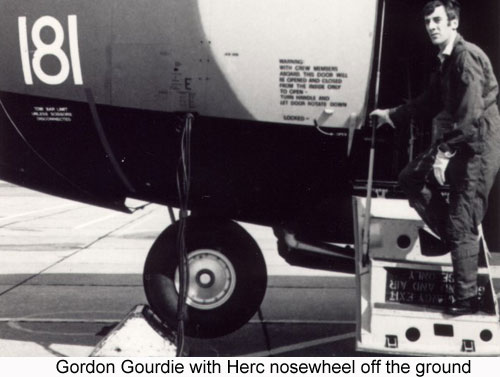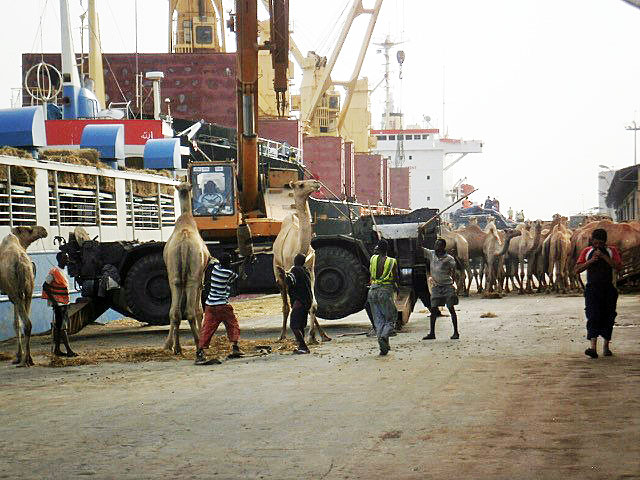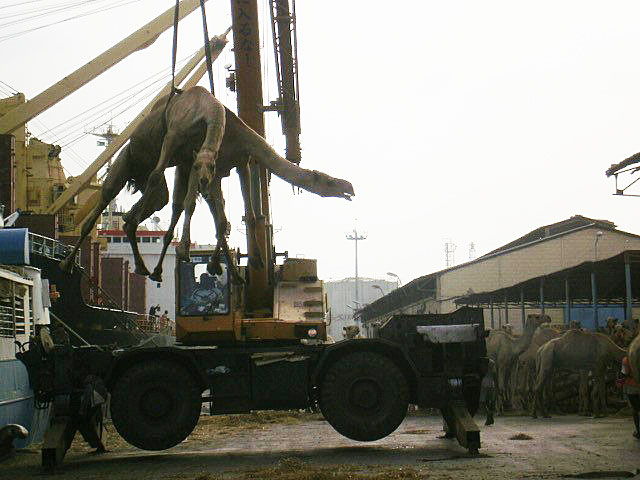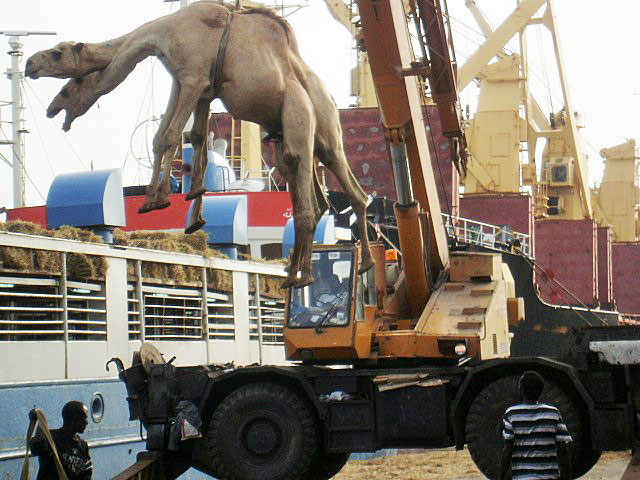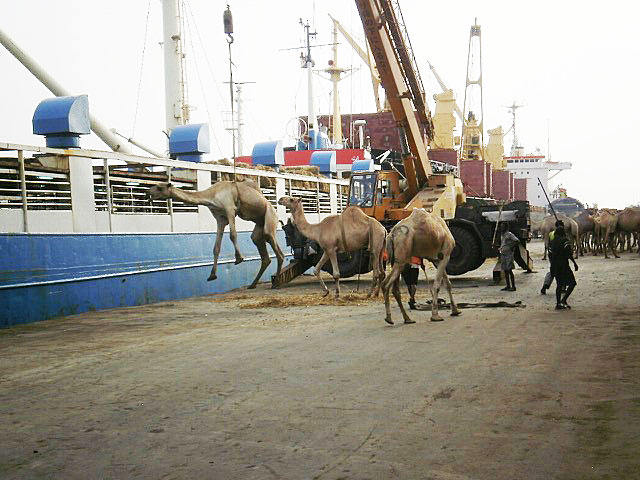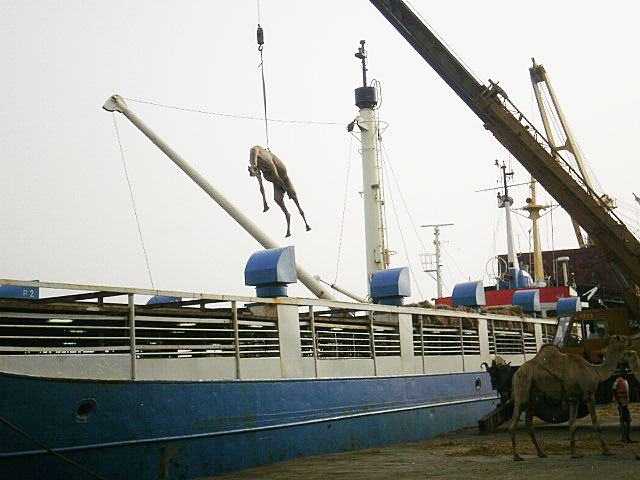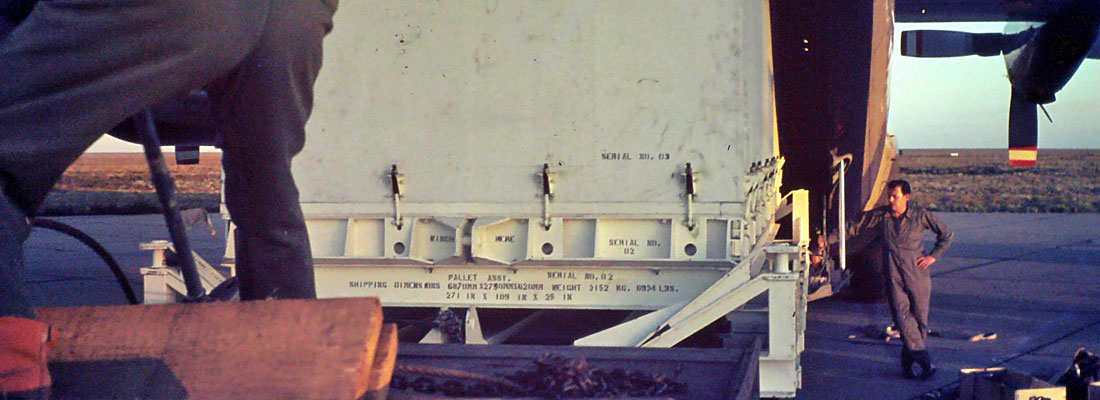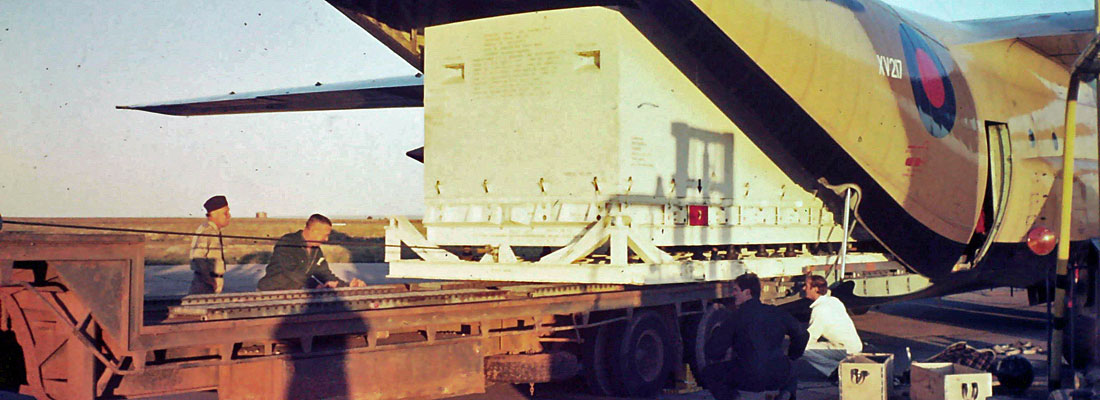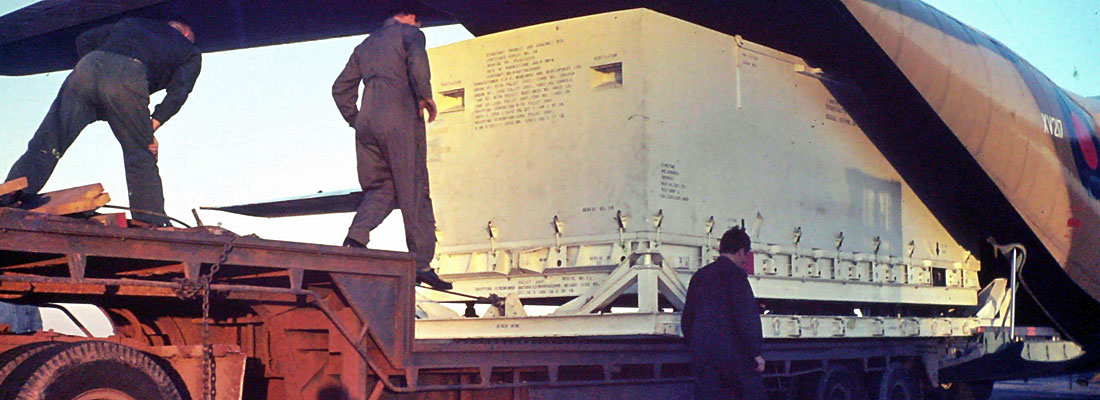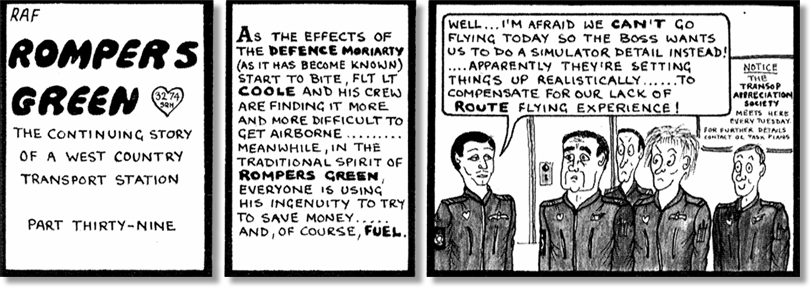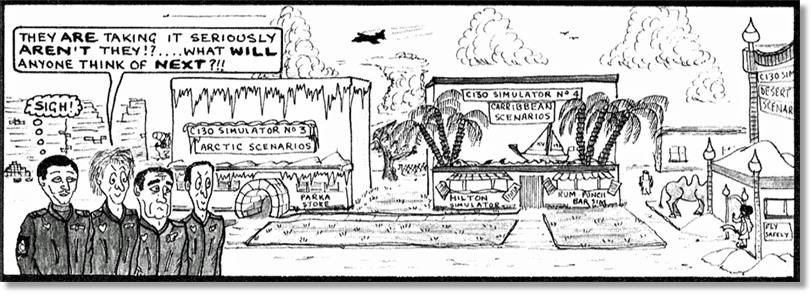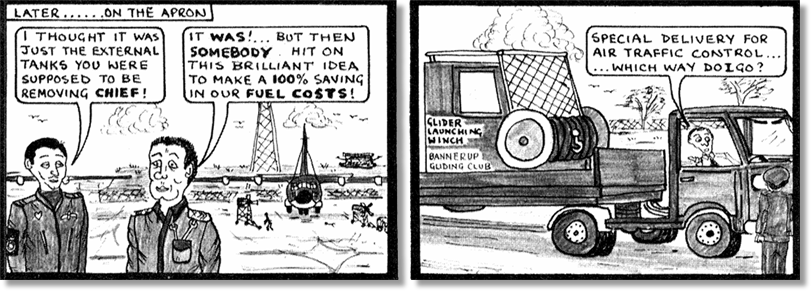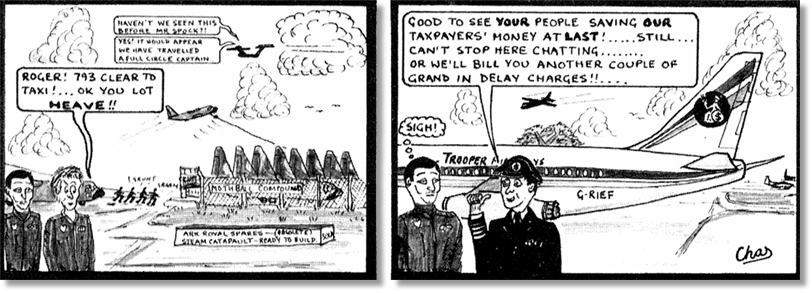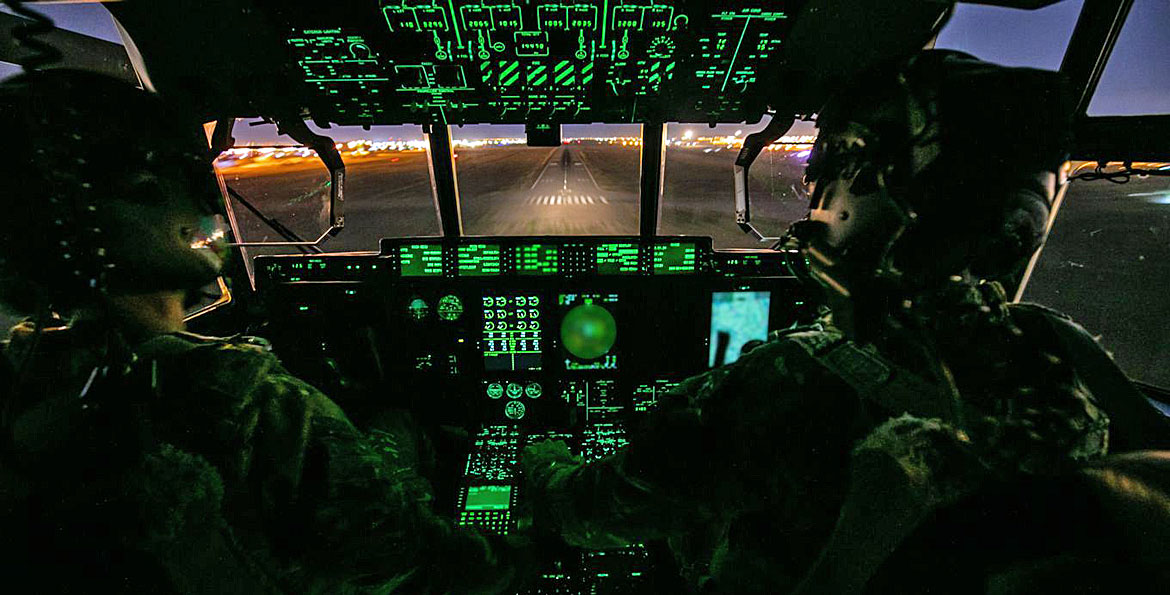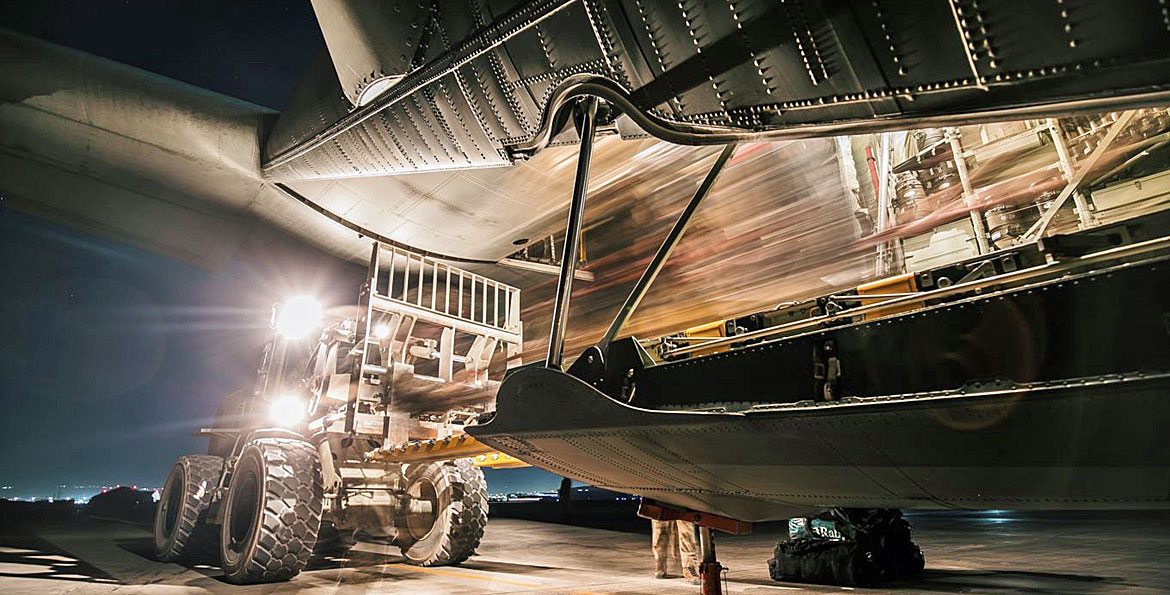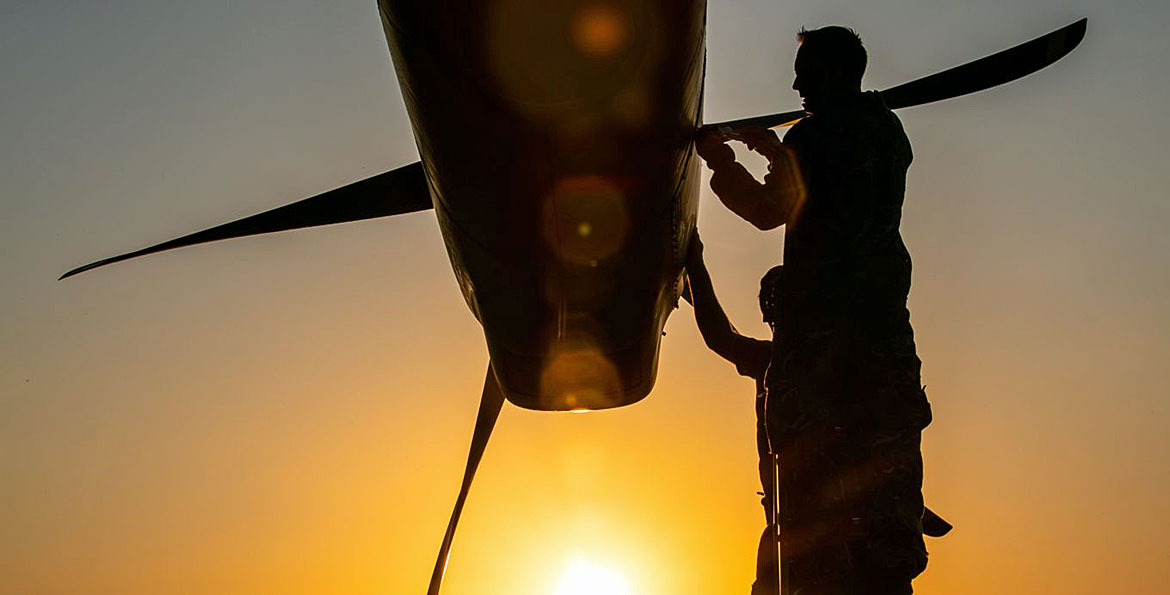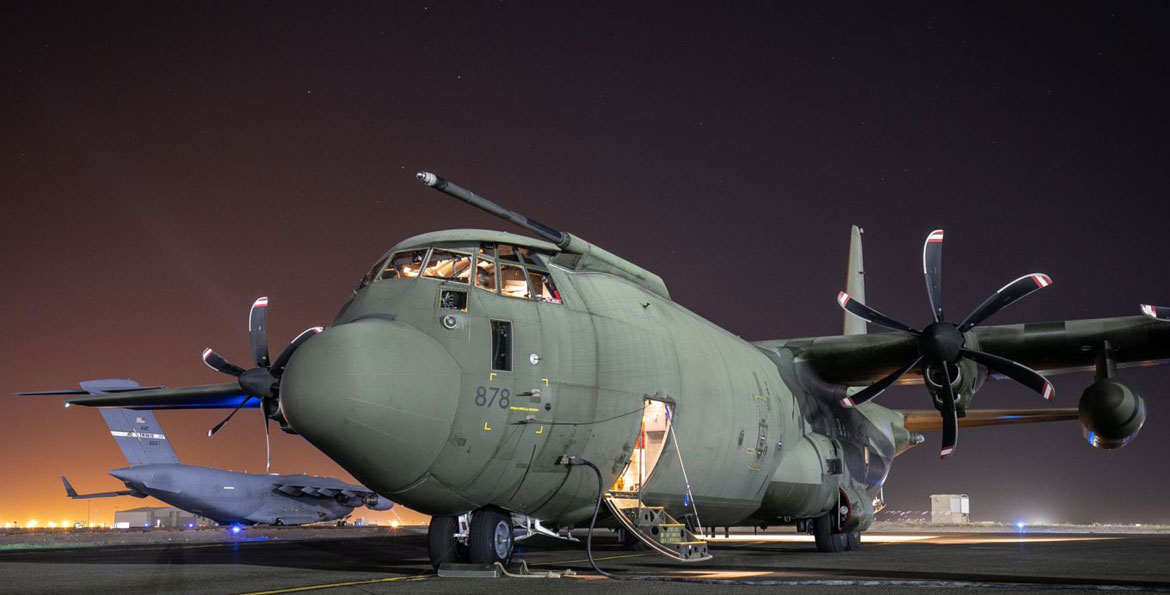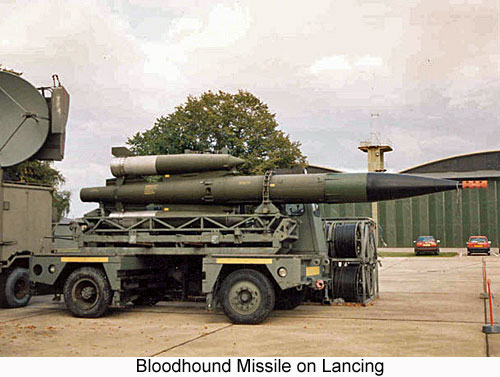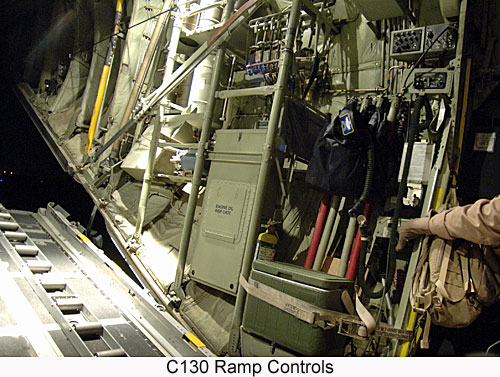


From: Michael V O'Brien, Corinda, QLD
Subject: Re: next UKMAMS OBA OBB (inspired by #053121)
Thanks Tony … once again, a good read, contributed by the assembled multitudes.
Re “camels … overnight”, “Looxury!” During Jan 2013, I was conducting a deployment to UNAMID of Djibouti Police with the majority of cargo being sea-moved from Port of Djibouti to Port Sudan, then road-moved to Darfur (“flexibility" being one of our Principles), and noted some commotion alongside the fine vessel chartered by the UN for my mob.
The reluctant ambulant cargo awaiting loading onto the vessel moored forward of us, and destined for Saudi Arabia, were apparently not too impressed with their mode of boarding, and no doubt had a less enjoyable journey than those being airfreighted in the clip in OBB #053121!
All the best,
OBie
Subject: Re: next UKMAMS OBA OBB (inspired by #053121)
Thanks Tony … once again, a good read, contributed by the assembled multitudes.
Re “camels … overnight”, “Looxury!” During Jan 2013, I was conducting a deployment to UNAMID of Djibouti Police with the majority of cargo being sea-moved from Port of Djibouti to Port Sudan, then road-moved to Darfur (“flexibility" being one of our Principles), and noted some commotion alongside the fine vessel chartered by the UN for my mob.
The reluctant ambulant cargo awaiting loading onto the vessel moored forward of us, and destined for Saudi Arabia, were apparently not too impressed with their mode of boarding, and no doubt had a less enjoyable journey than those being airfreighted in the clip in OBB #053121!
All the best,
OBie
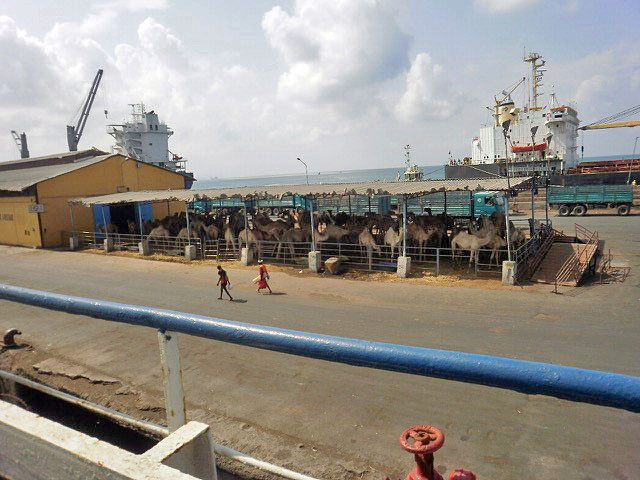

From: Roger Whittington, Prescot, Merseyside
Subject: Embassy Drinks
Hi Tony, thanks for yet another brilliant newsletter.
Reading Andy Spinks’ tale in which he mentioned his team being invited to HM Ambassador’s Queen’s Birthday cocktail party in Tel Aviv reminded me of a cocktail party that we were invited to in Addis Ababa in Ethiopia during Op Bushel in 1985. I say we were invited but it was actually a three-line whip and we were told in no uncertain terms that if we didn’t attend it would be a fate worse than death for us; probably two weeks working in clothing stores or something equally sadistic! It was the Battle of Britain cocktail party at the British Embassy and it all sounded like a great way to unwind during a very hard detachment.
My team was working that day; we had a very early start, up at 0500hrs and chocks at 0700hrs. We flew around for a couple of hours to give the flight deck crew a chance to do a bit of low-level and sightseeing flying, then it was down to Assab on the Red Sea coast to pick up our first load. To say this place was hot was an understatement! You could feel the walls of the aircraft heating up as we descended and the humidity was horrendous. Then it was a scramble to load three 14,000lb stacks of grain sacks before taking off for the distribution centre at Mekele up in the mountains. We did this run three times each day and by the time we got back to the hotel we looked like walking dungheaps. It was noticeable that the notoriously bad tempered and rapacious flies that haunted the city would rather fly into the open mouths of lizards than land on us!
Subject: Embassy Drinks
Hi Tony, thanks for yet another brilliant newsletter.
Reading Andy Spinks’ tale in which he mentioned his team being invited to HM Ambassador’s Queen’s Birthday cocktail party in Tel Aviv reminded me of a cocktail party that we were invited to in Addis Ababa in Ethiopia during Op Bushel in 1985. I say we were invited but it was actually a three-line whip and we were told in no uncertain terms that if we didn’t attend it would be a fate worse than death for us; probably two weeks working in clothing stores or something equally sadistic! It was the Battle of Britain cocktail party at the British Embassy and it all sounded like a great way to unwind during a very hard detachment.
My team was working that day; we had a very early start, up at 0500hrs and chocks at 0700hrs. We flew around for a couple of hours to give the flight deck crew a chance to do a bit of low-level and sightseeing flying, then it was down to Assab on the Red Sea coast to pick up our first load. To say this place was hot was an understatement! You could feel the walls of the aircraft heating up as we descended and the humidity was horrendous. Then it was a scramble to load three 14,000lb stacks of grain sacks before taking off for the distribution centre at Mekele up in the mountains. We did this run three times each day and by the time we got back to the hotel we looked like walking dungheaps. It was noticeable that the notoriously bad tempered and rapacious flies that haunted the city would rather fly into the open mouths of lizards than land on us!
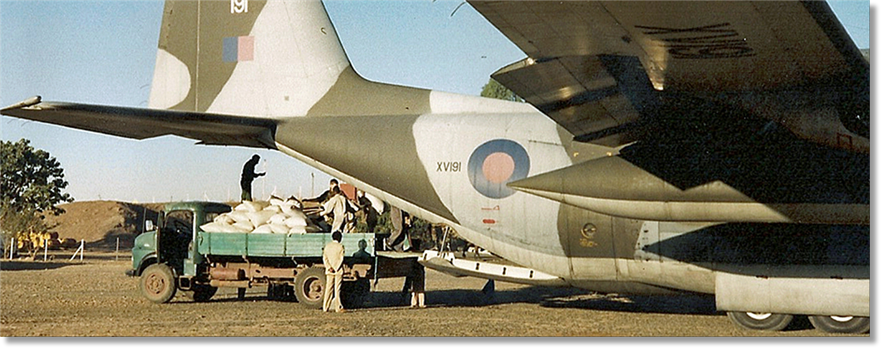
We didn’t have much time to get dressed for the party so we rushed off the bus into the foyer where, to our consternation, there was a sign saying that there was no water throughout the hotel because of problems with the water supply. A fly on the wall would then have had the hilarious sight of a movements team trying to clean our sweaty, manky bodies using only the serviettes, fully 4 inches by 3 inches, provided in our lumpy boxes. Bruce Phillips, ever resourceful, had a whole sick-bag full but we soon tore through those.
The result was a bunch of movers who smelled like lemons but looked like we’d been dragged backwards through a slurry pit, ambling up the path to the Embassy while the night creatures of Addis that normally sounded like a particularly heavy bombing raid over a wartime German city, fell suspiciously silent.
Once inside we were handed drinks and then surreptitiously ushered over to a particularly deserted corner so as not to cause too much offence and it wasn’t too long before one of our number needed to go and point Percy at the porcelain. They came back 20-minutes later looking refreshed and happy with the news that in the downstairs toilet there happened to be a shower! Cue a sudden file of movers trying to sneak off without attracting attention. All went well, the only problem being that there were no towels provided. How inconsiderate and unwelcoming! So, being adaptive, and desperate, and using admirable improvisational skills, the window curtains were taken down and used for a whole new purpose.
Apologies to the Embassy for the mess we must have left for them to clean up!
Cheers now, Roger
The result was a bunch of movers who smelled like lemons but looked like we’d been dragged backwards through a slurry pit, ambling up the path to the Embassy while the night creatures of Addis that normally sounded like a particularly heavy bombing raid over a wartime German city, fell suspiciously silent.
Once inside we were handed drinks and then surreptitiously ushered over to a particularly deserted corner so as not to cause too much offence and it wasn’t too long before one of our number needed to go and point Percy at the porcelain. They came back 20-minutes later looking refreshed and happy with the news that in the downstairs toilet there happened to be a shower! Cue a sudden file of movers trying to sneak off without attracting attention. All went well, the only problem being that there were no towels provided. How inconsiderate and unwelcoming! So, being adaptive, and desperate, and using admirable improvisational skills, the window curtains were taken down and used for a whole new purpose.
Apologies to the Embassy for the mess we must have left for them to clean up!
Cheers now, Roger
RAAF helping out India, Nepal and Sri Lanka
One of our C-17A Globemasters has transported a large oxygen tank to India and humanitarian stores to Nepal and Sri Lanka. The crew from No. 36 Squadron made contactless deliveries to our three regional partners and complied with Australian and international COVID-19 measures to minimise risk to both ADF personnel and our neighbours. This included COVID-19 testing and a 14-day quarantine period upon return to Australia, and wearing of personal protective equipment. The above picture shows a Royal Australian Air Force C-17A Globemaster III from Western Australia, sitting on the tarmac at Tribhuvan International Airport in Nepal.
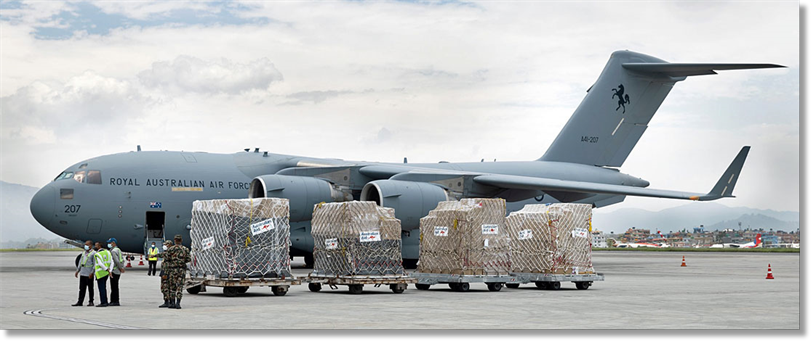
Department of Foreign Affairs and Trade officer, Mr Dylan Walsh, Leading Aircraftsman Tom Cockeram and Leading Aircraftswoman Kimberley Blackwood from RAAF Base Pearce load an aircraft palette with humanitarian stores at Perth Airport as part of the Australian Government's support to India, Nepal and Sri Lanka in their fight against the spread of COVID-19.
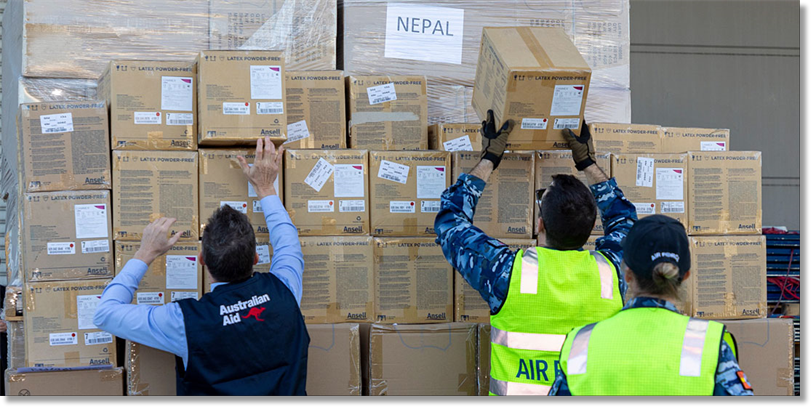
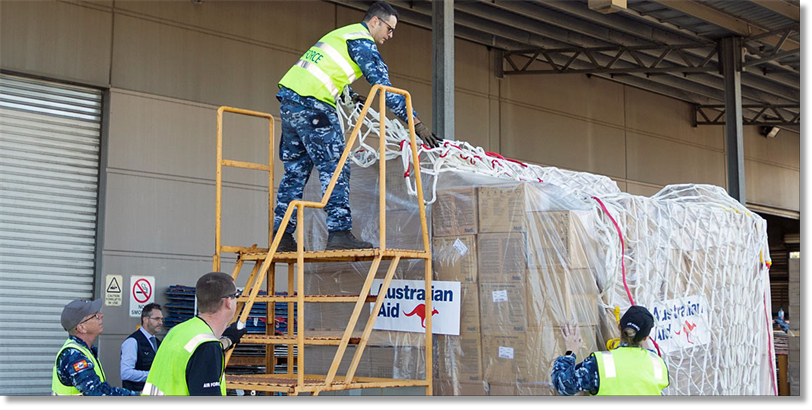
Some of our personnel secure a net onto an aircraft palette of humanitarian stores at Perth Airport as part of the Australian Government's support to India, Nepal and Sri Lanka in their fight against the spread of COVID-19.
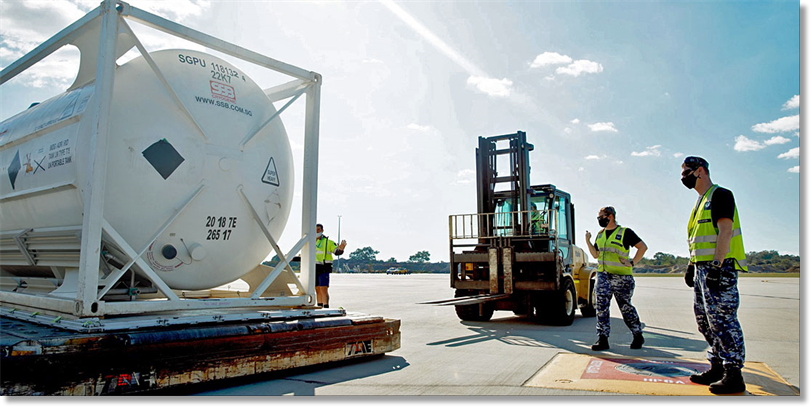
Corporal Caroline Thomas and Corporal Christopher Gorton coordinate the movement of an oxygen tank to be transferred to a Royal Australian Air Force C-17A Globemaster III at Perth Airport before being flown to India as part of Australia's support to regional partners in the fight against COVID-19.
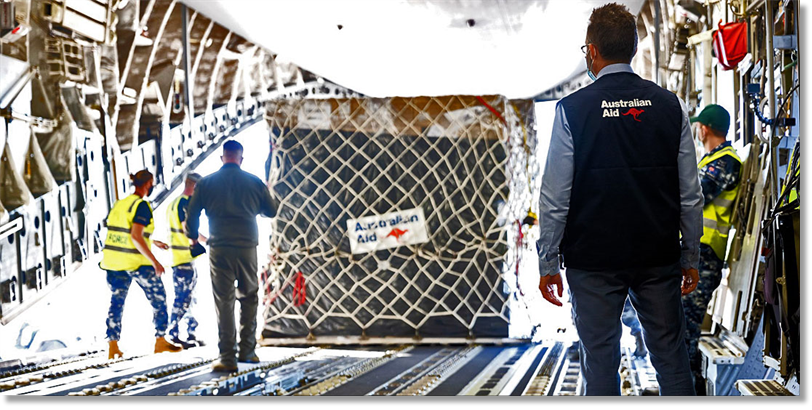
Deputy Director, Western Australia state office the Department of Foreign Affairs and Trade, Dylan Walsh watches as an oxygen tank is transferred to a Royal Australian Air Force C-17A Globemaster III at Perth Airport before being flown to India as part of Australia's support to regional partners in the fight against COVID-19
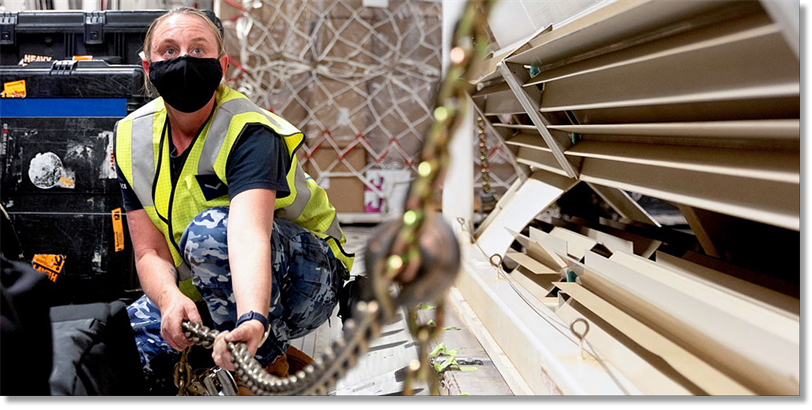
Leading Aircraftwoman Kim Blackwood fastens an oxygen tank to the inside of a Royal Australian Air Force C-17A Globemaster III.
All Photos by: Corporal Robert Whitmore / Leading Seaman Ronnie Baltoft.
#AusAirForce
All Photos by: Corporal Robert Whitmore / Leading Seaman Ronnie Baltoft.
#AusAirForce

From: Arthur Rowland, St Ives, Cambs
Subject: Re: UKMAMS OBA OBB #043021
Hi Tony,
It was good to read Norman Stamper's tribute to Tommy Brown in your May edition. Yes, it was a small Movements team back then, but their professionalism was always outstanding. Whether it was handling Royals, or other VIP's at all hours of the day or night, or handling some very "interesting" payloads their humour and dedication to the task was an inspiration to the Logistics Wing. I still treasure the 5000lb tensioner and stand which they presented to me when I left Berlin. The attached plaque on the tensioner reads " To relieve tension screw weekly" !
All the best
Arthur
Subject: Re: UKMAMS OBA OBB #043021
Hi Tony,
It was good to read Norman Stamper's tribute to Tommy Brown in your May edition. Yes, it was a small Movements team back then, but their professionalism was always outstanding. Whether it was handling Royals, or other VIP's at all hours of the day or night, or handling some very "interesting" payloads their humour and dedication to the task was an inspiration to the Logistics Wing. I still treasure the 5000lb tensioner and stand which they presented to me when I left Berlin. The attached plaque on the tensioner reads " To relieve tension screw weekly" !
All the best
Arthur
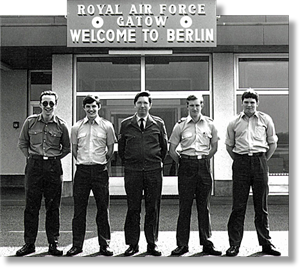

From: Andrew Spinks, Falmouth, Cornwall
Subject: Hazmat meets Murphy
Hi Tony,
I have only one hazmat story, but it remains in my memory because of the injustice (IMHO) caused to an ALM who was one of the good guys. Just while on this topic, there will be lots of OBA members, especially from Canada, who have been ALMs. I always thought that the RAF should adopt the CAF/RCAF policy of starting as movers and then becoming ALMs (and reverting to being a movements SNCO/officer later in their careers). It always seemed to me that, if we had all been through the same training and first few tours, there would have been a lot less friction between the ALMs and movers. I tried to push this through when I was in MoD (Air Plans) but didn’t get very far.
Back to my hazmat story. I was doing my stint as a DAMO at Lyneham in the days when team leaders were rotated onto base shifts as DAMOs for 4 months. The C130 I was despatching was off to Belize and carrying some DAC, including some very small compressed gas cylinders. I cannot remember which gas, but that is not relevant – they were DAC and so loaded next to the para door. Because they were small (maybe for a life raft or life jacket) and loose, ie not packaged or boxed, they were very difficult to restrain. The loading team had stowed them under a baggage net and this seemed a reasonable restraint to myself as the DAMO signing the trim sheet and the ALM. Off went the aircraft on its way across the Atlantic.
About 24 hours later, I got a call from a now very distressed ALM. A route checker had got on board in Nassau (strange that he had been lurking in Nassau, but there we go), had checked the load and did not like the way the small cylinders had been restrained. But, worse, because of it he grounded the ALM, who was understandably distraught and asked for my help. I remembered everything about the load – thank goodness that I had always been determined to check a load before signing the trim sheet - and was able to explain exactly where they were, how they had been restrained, and the impossibility of restraining them without putting them in a container which, anyway, would probably not have met the JSP 335 regs.
I don’t think the temporary grounding of the ALM was overturned as a result of my acting for the defence, so I can’t write that my intervention immediately righted the wrong. Fortunately, he got his Cat back in due course, but the injustice of his temporary grounding stays in my memory.
Perhaps the route checking ALM was “MALM Murphy”?
Regards, Andy
Subject: Hazmat meets Murphy
Hi Tony,
I have only one hazmat story, but it remains in my memory because of the injustice (IMHO) caused to an ALM who was one of the good guys. Just while on this topic, there will be lots of OBA members, especially from Canada, who have been ALMs. I always thought that the RAF should adopt the CAF/RCAF policy of starting as movers and then becoming ALMs (and reverting to being a movements SNCO/officer later in their careers). It always seemed to me that, if we had all been through the same training and first few tours, there would have been a lot less friction between the ALMs and movers. I tried to push this through when I was in MoD (Air Plans) but didn’t get very far.
Back to my hazmat story. I was doing my stint as a DAMO at Lyneham in the days when team leaders were rotated onto base shifts as DAMOs for 4 months. The C130 I was despatching was off to Belize and carrying some DAC, including some very small compressed gas cylinders. I cannot remember which gas, but that is not relevant – they were DAC and so loaded next to the para door. Because they were small (maybe for a life raft or life jacket) and loose, ie not packaged or boxed, they were very difficult to restrain. The loading team had stowed them under a baggage net and this seemed a reasonable restraint to myself as the DAMO signing the trim sheet and the ALM. Off went the aircraft on its way across the Atlantic.
About 24 hours later, I got a call from a now very distressed ALM. A route checker had got on board in Nassau (strange that he had been lurking in Nassau, but there we go), had checked the load and did not like the way the small cylinders had been restrained. But, worse, because of it he grounded the ALM, who was understandably distraught and asked for my help. I remembered everything about the load – thank goodness that I had always been determined to check a load before signing the trim sheet - and was able to explain exactly where they were, how they had been restrained, and the impossibility of restraining them without putting them in a container which, anyway, would probably not have met the JSP 335 regs.
I don’t think the temporary grounding of the ALM was overturned as a result of my acting for the defence, so I can’t write that my intervention immediately righted the wrong. Fortunately, he got his Cat back in due course, but the injustice of his temporary grounding stays in my memory.
Perhaps the route checking ALM was “MALM Murphy”?
Regards, Andy
8 facts you need to know about the Airbus A400M Atlas
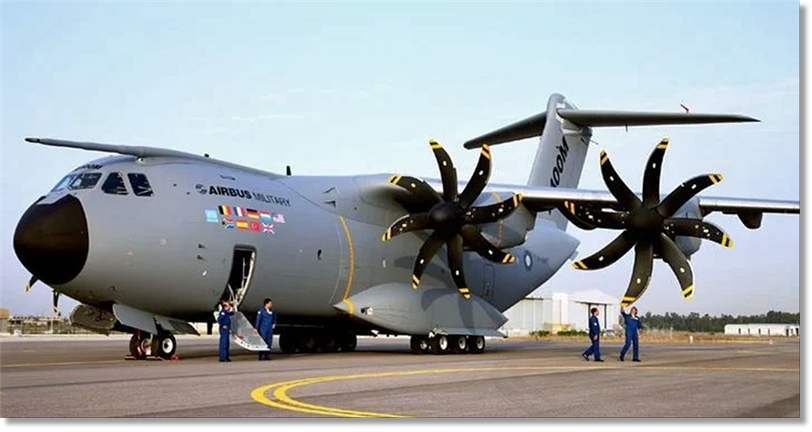
The C-130 Hercules has been the legendary heavy lift cargo transport of choice for years in the western air forces. It has been in service since being introduced during the mid-1950s and has seen itself adapted into other roles like the AC-130 Gunship. It is now one of the oldest military aircraft in service. But while it is continuing strong in American service, it is being replaced in Europe with their Airbus A400M Atlas.
The Atlas has been in service since 2013 and is now servicing in a range of European air forces. The Americans, on the other hand, have been happy to modernize and adapt the C-130 Hercules. Here is everything you need to know about the Airbus A400M Atlas, the European replacement for the C-130 Hercules.
The Atlas has been in service since 2013 and is now servicing in a range of European air forces. The Americans, on the other hand, have been happy to modernize and adapt the C-130 Hercules. Here is everything you need to know about the Airbus A400M Atlas, the European replacement for the C-130 Hercules.
8 Purpose
The Airbus A400M Atlas was intended as an intermediate size and range option between the Lockheed C-130 and Boeing C-17. It is able to carry cargo too large or heavy for the C-130, and it is also able to land on rough landing strips. In fact, cargo capacity is around double that of the older aircraft. It is able to carry equipment like a Patriot missile system, six Land Rovers and trailers, or a truck and 25-ton trailer.
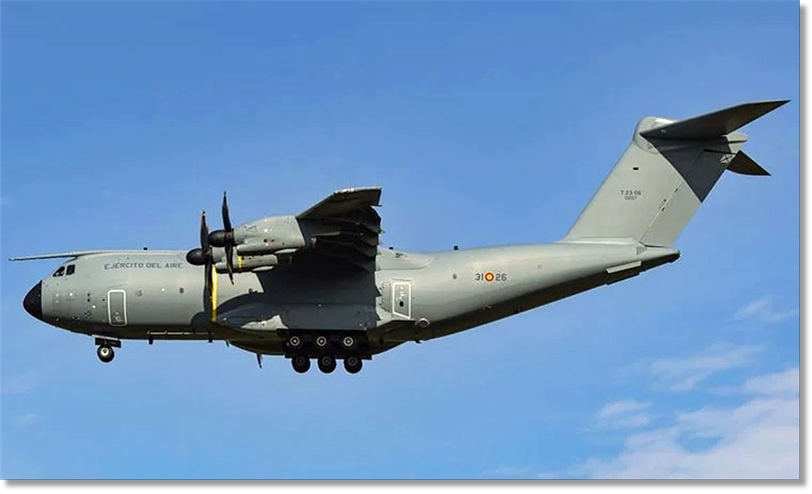
7 The Super Hercules
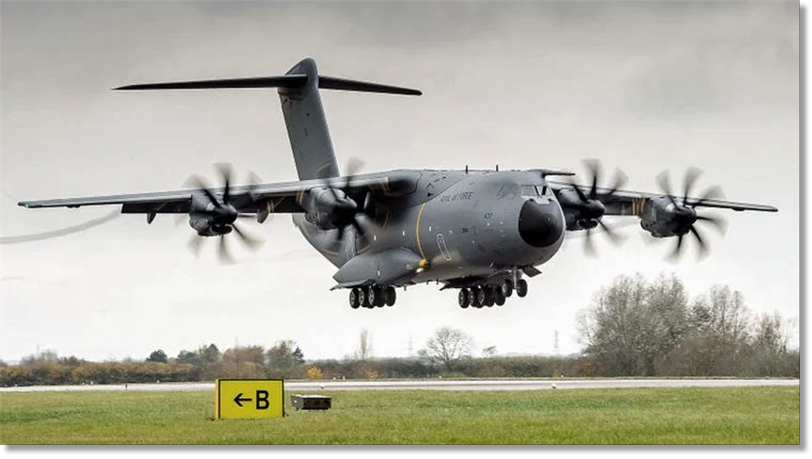
Lockheed was initially a part of the project, but they pulled out in 1989 early on in the design. Instead, Lockheed decided to focus on upgrading its existing C-130 Hercules, and it went on to produce the upgraded C-130J Super Hercules. The Super Hercules is now the newest model of the Hercules and the only one still in production. The Super Hercules has also proven more popular for export, having been exported to 17 countries around the world — including the Royal Air Force, which also has the Airbus A400M Atlas in service. While the Super Hercules is popular around the world, it has a considerably smaller cargo capacity, carries fewer troops, and has a much shorter range than the Atlas.
6 Delays and near cancellation

Like many projects, the development of the Airbus A400M Atlas was difficult, and it fell behind schedule and ran over budget. This nearly caused the project to be canceled by Airbus, however, the member European states decided to press on and loan Airbus more money to complete the project. One problem was that the development of the A400M Atlas was happening while Airbus was working on the A380 and A350 and was seen as competing for resources.
5 Current Operators
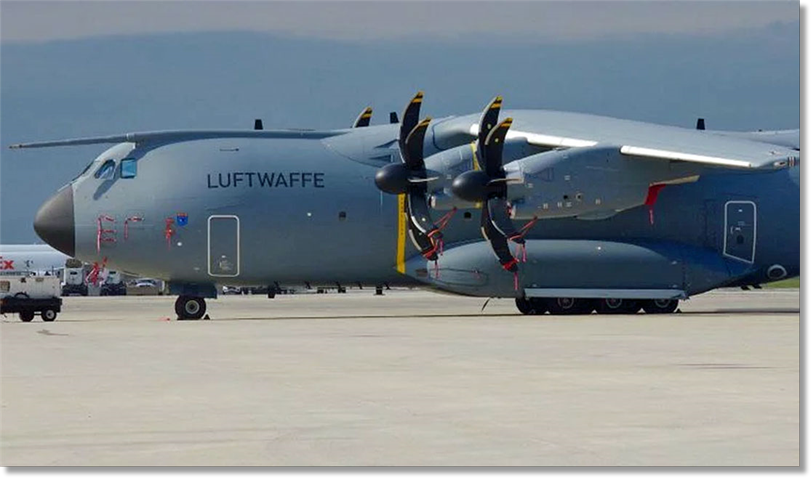
Most air forces operating these aircraft are European. The Germans have ordered the most at 53, then the French with 50, the Spanish ordered 27, the British 22, the Turkish 10, Belgium at 7, and even little old Luxembourg has one. Further afield, the Malaysians have 4. The Germans have tried to sell off 13 of their fleet, but have failed to find a buyer. The A400M Atlas's have also only seen very minimal combat experience to date.
The A400M Atlas has a capacity of 37 tons or 81,600 lbs and has a crew of 3 or 4. It can carry up to 116 fully equipped troops or para-troopers, together with space for other supporting personal and equipment. It has a max take-off weight of 141 tons or 311,000 lbs and a max landing weight of 123 tons or 271,000 lbs.
4 Specifications
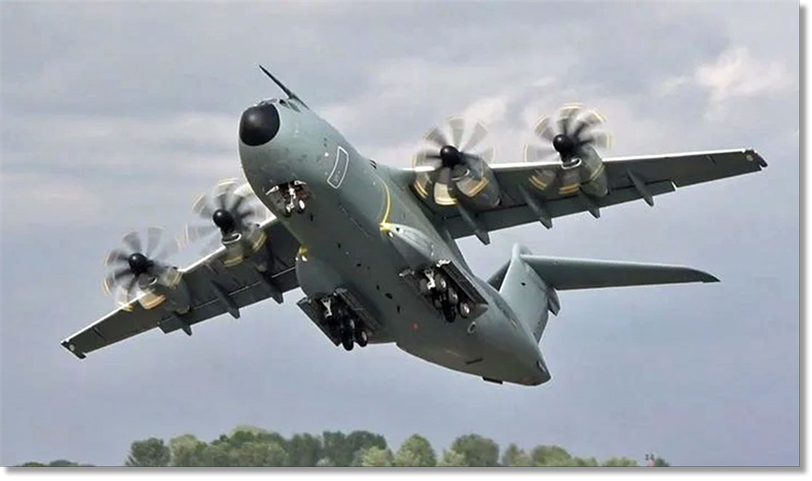
3 Performance
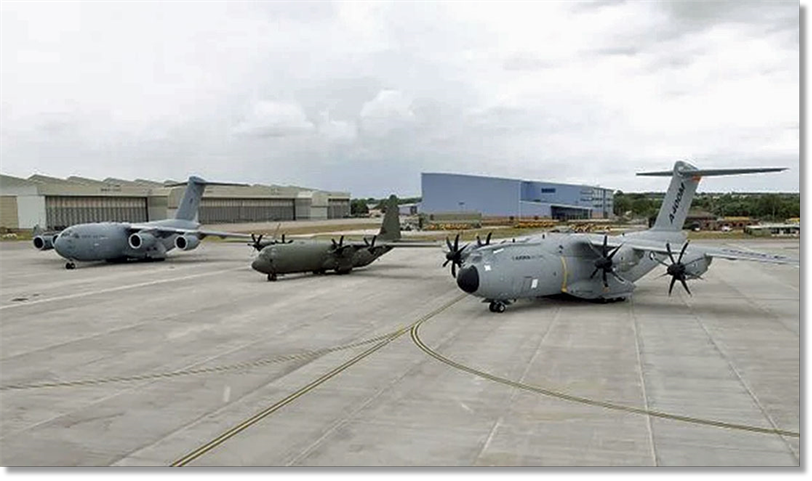
The Atlas is powered by four Europrop TP400-D6 turboprop, 8,200 kW (11,000 hp) engines. It has a maximum speed of Mach 0.72 and a cruise speed of 485 mph. Its service ceiling is 12,200 meters or 40,000 feet. Range depends on its payload and speed, but with a 30-ton payload, its range is some 4,500 km or 2,800 miles, and at 20 tons that increases to 6,400 km or 4,000 miles.
2 Design
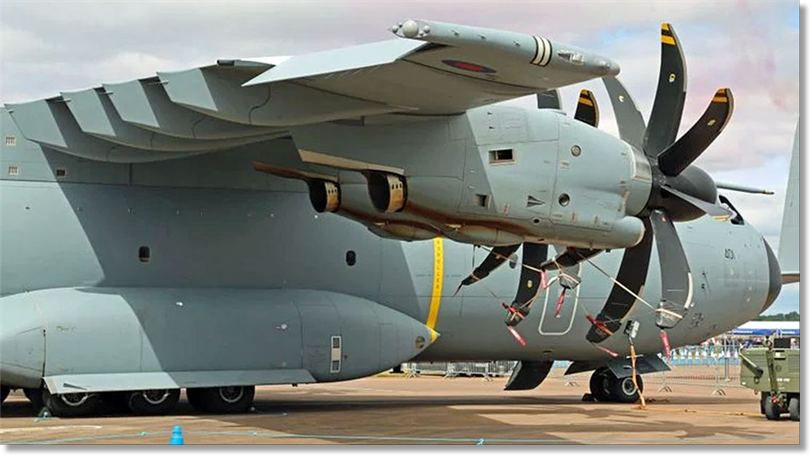
The Airbus A400M Atlas features a fly-by-wire system and has around 30% of its structure made of composite materials. Its propellers are also made of woven composite materials. Unlike the Hercules (which features straight wings), the A400M Atlas has a swept-wing design.
The Atlas also comes with a forward-looking infrared enhanced vision system (EVS) camera that provides an enhanced view of the terrain in low light conditions. It can also carry up to 25,000 kg (55,116 lb) of fuel, and it can refuel mid-air.
The Atlas also comes with a forward-looking infrared enhanced vision system (EVS) camera that provides an enhanced view of the terrain in low light conditions. It can also carry up to 25,000 kg (55,116 lb) of fuel, and it can refuel mid-air.
1 Its Propellers
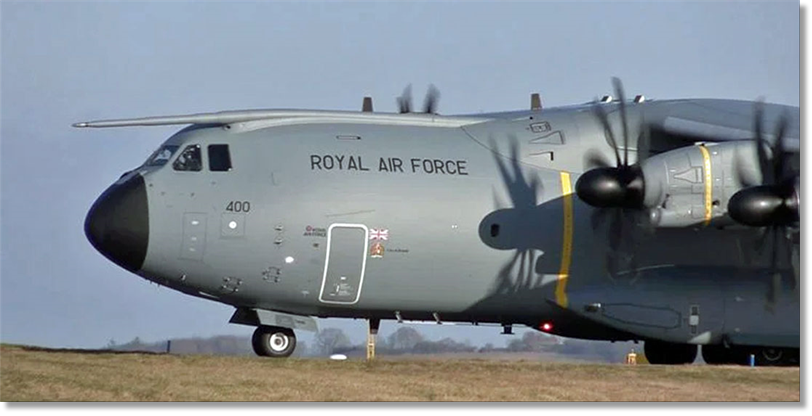
When it comes to its propellers, each pair turns in opposite directions. Its Ratier-Figeac FH385 propellers turn counterclockwise and the FH386 propellers turn clockwise. This is unusual as the vast majority of multi-propped aircraft have their propellers turning in the same direction. The counter-rotating propellers are achieved by having a gearbox that reverses the rotation of the propeller. This eliminates the need to have engines that operate in reverse of each other. This design increases lift and decreases the torque and prop wash on each wing. Additionally, it decreases yaw in the case of an engine failure. In summary, the Airbus A400M Atlas managed to defy the odds and come into service. Today, it offers a larger and more capable option to air forces looking for a heavier military cargo aircraft than the Super Hercules.
Aaron Joshua Spray - hotcars.com
Aaron Joshua Spray - hotcars.com

From: David Powell, Princes Risborough, Bucks
Subject: Hazmat meets Murphy
Hi Tony,
One story springs to mind from the days of Gulf MAMS. I can’t remember dates etc., but it was a loading at Muharraq during the run down. As sometimes happened, we would help out the Unit Movers by taking on certain more complex and time consuming jobs while they got on with the day-to-day work. In this case it was a Belfast with a couple of Army senior officer taxis, aka, Westland Scouts.
The load and been properly prepared and securely loaded. Then what followed was one of those Monty Python sequences that are sent to entertain movers, especially tired, hot and sweaty ones.
A young loadmaster arrives, eventually. He has been sent to check the load. This is his first overseas trip after training. Checks done, he comes back to me and a conversation ensues:
Subject: Hazmat meets Murphy
Hi Tony,
One story springs to mind from the days of Gulf MAMS. I can’t remember dates etc., but it was a loading at Muharraq during the run down. As sometimes happened, we would help out the Unit Movers by taking on certain more complex and time consuming jobs while they got on with the day-to-day work. In this case it was a Belfast with a couple of Army senior officer taxis, aka, Westland Scouts.
The load and been properly prepared and securely loaded. Then what followed was one of those Monty Python sequences that are sent to entertain movers, especially tired, hot and sweaty ones.
A young loadmaster arrives, eventually. He has been sent to check the load. This is his first overseas trip after training. Checks done, he comes back to me and a conversation ensues:
LM: “Can’t take them, you’ll have to offload the helicopters”.
DP: "Why?”
LM: “They are DAC and we are a D-Cat crew on a training flight and not qualified to transport DAC!”
DP: “What do you mean, what DAC? Where’s the crate of ammo or a pallet of gas cylinders? Furthermore, this training flight was specifically tasked to recover these two helicopters.”
LM: “Come with me.” <pause for mutual glare> “Sir!" The loadmaster escorts me to the first helicopter and points into its cockpit. “There! Fire extinguishers. They is DAC!”
DP: "Come with me, please.” I escort the loadmaster further into his Belfast. “What are those?” pointing to fire extinguishers fitted to the aircraft side walls.
LM: “Ah, but those came with the aircraft”.
DP: “So, if they are dangerous, why did you not have them removed before you left Brize?”
LM: “I was assured they were safe before we took off.”
DP: “So, if I assure you that those extinguishers in those helicopters are the same ones that were fitted before they were flown across to Muharraq, that will mean that the helicopter pilot was happy they were safe before he took off to come here, what’s the difference?”
LM: “But those are Army ones!”
Thankfully by now the rest of the crew had arrived, and sanity in the shape of familiar skipper who was not happy that his load was being rejected and he and his crew would be significantly delayed.
AC: “Well just remove the ones from the helicopters!” Suggested the Skipper.
LM: “But then they would be unsafe, and I cannot handover an unsafe load!"
DP: "Or, if you are willing to take the risk perhaps we could always swap the identical, albeit RAF, fire extinguishers, for the Army ones in the loaded helicopters? Meanwhile, if we don’t get you away pretty soon you’ll be out of crew duty time!”
Exit Belfast, loaded.
Stay safe, stay sane!
David
DP: "Why?”
LM: “They are DAC and we are a D-Cat crew on a training flight and not qualified to transport DAC!”
DP: “What do you mean, what DAC? Where’s the crate of ammo or a pallet of gas cylinders? Furthermore, this training flight was specifically tasked to recover these two helicopters.”
LM: “Come with me.” <pause for mutual glare> “Sir!" The loadmaster escorts me to the first helicopter and points into its cockpit. “There! Fire extinguishers. They is DAC!”
DP: "Come with me, please.” I escort the loadmaster further into his Belfast. “What are those?” pointing to fire extinguishers fitted to the aircraft side walls.
LM: “Ah, but those came with the aircraft”.
DP: “So, if they are dangerous, why did you not have them removed before you left Brize?”
LM: “I was assured they were safe before we took off.”
DP: “So, if I assure you that those extinguishers in those helicopters are the same ones that were fitted before they were flown across to Muharraq, that will mean that the helicopter pilot was happy they were safe before he took off to come here, what’s the difference?”
LM: “But those are Army ones!”
Thankfully by now the rest of the crew had arrived, and sanity in the shape of familiar skipper who was not happy that his load was being rejected and he and his crew would be significantly delayed.
AC: “Well just remove the ones from the helicopters!” Suggested the Skipper.
LM: “But then they would be unsafe, and I cannot handover an unsafe load!"
DP: "Or, if you are willing to take the risk perhaps we could always swap the identical, albeit RAF, fire extinguishers, for the Army ones in the loaded helicopters? Meanwhile, if we don’t get you away pretty soon you’ll be out of crew duty time!”
Exit Belfast, loaded.
Stay safe, stay sane!
David
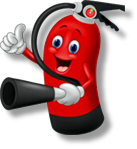

From: Ian Berry, West Swindon, Wilts
Subject: Hazmat meets Murphy- Never let an officer touch the controls!
Tony, as you will recall, one of our "bread and butter" tasks during the 1970s was the twice-weekly missile exchange (Missex) between (usually) West Raynham and a German "Clutch" station. This involved the rotation of three Bloodhound Missiles and ancillaries. Three serviced missiles would be flown out to Germany and three brought back for servicing.
The missiles were usually brought out to the aircraft and then transferred to a 10 ton 40 foot trailer which was rollered using a Lancing Side Loading Forklift. Sometimes, the sill height of the C130 was wrong, and so the trick was to disconnect the ADS arms and then manually pump up or down the ramp until all was level.
After several of these rotations, my officer, AJH, asked if he could operate the ramp controls for the offload at West Raynham; reluctantly we agreed. As he was NOT being closely monitored, it transpired he had selected the Pump No 3 (raise) setting as against No 6 (lower). Nothing noticeably happened, but in fact the aircraft ramp stool, hidden by the trailer, had fallen over! The next thing we noticed was that the trailer seemed to be raising itself.
In reality, with the weight of the missile near the ramp being more than forward of the C of G, made the aircraft tip. The air turned blue and the officer was given a reverse career brief by the Flight Sergeant! Myself and Gordon Gourdie adjourned to the outside of the aircraft, not wishing to witness violence! Eventually, we managed to raise the ramp and replace the stool and carried on with the offload. I think the operating crew were as bemused as we were. I do know that we had proved you could safely tip a C130 some years before JATE did!
Regards,
Ian
Subject: Hazmat meets Murphy- Never let an officer touch the controls!
Tony, as you will recall, one of our "bread and butter" tasks during the 1970s was the twice-weekly missile exchange (Missex) between (usually) West Raynham and a German "Clutch" station. This involved the rotation of three Bloodhound Missiles and ancillaries. Three serviced missiles would be flown out to Germany and three brought back for servicing.
The missiles were usually brought out to the aircraft and then transferred to a 10 ton 40 foot trailer which was rollered using a Lancing Side Loading Forklift. Sometimes, the sill height of the C130 was wrong, and so the trick was to disconnect the ADS arms and then manually pump up or down the ramp until all was level.
After several of these rotations, my officer, AJH, asked if he could operate the ramp controls for the offload at West Raynham; reluctantly we agreed. As he was NOT being closely monitored, it transpired he had selected the Pump No 3 (raise) setting as against No 6 (lower). Nothing noticeably happened, but in fact the aircraft ramp stool, hidden by the trailer, had fallen over! The next thing we noticed was that the trailer seemed to be raising itself.
In reality, with the weight of the missile near the ramp being more than forward of the C of G, made the aircraft tip. The air turned blue and the officer was given a reverse career brief by the Flight Sergeant! Myself and Gordon Gourdie adjourned to the outside of the aircraft, not wishing to witness violence! Eventually, we managed to raise the ramp and replace the stool and carried on with the offload. I think the operating crew were as bemused as we were. I do know that we had proved you could safely tip a C130 some years before JATE did!
Regards,
Ian

From: Allan Walker, Burnley, Lancashire
Subject: Hazmat meets Murphy
Hi Tony,
My Hazamat story began on a regular Hazmat Missex (Bloodhounds) by Herc from West Raynham to Bruggen. In addition to my team was Flt Lt Norrie Radcliffe, who was coming along for the ride. We were half way across the North Sea when suddenly there was a huge mist of an unknown substance flowing out of one of the Missiles. This mist covered the entire aircraft hold.
Not knowning what it was, I saw Norrie dashing towards the front of the aircraft to find a fire extinguisher. At the same time the Loadmaster was dashing towards the rear of the aircraft. Once there, he opened the ramp door and the mist cleared.
It was eventually established the the missile had not been properly prepared for flight and due to the change of air pressure in the aircraft, the residual fuel had vented off. After the mist had cleared it was back to normal, but during the time it was in the aircaft there were many "Half-a-Crown/Sixpence" experiences! We never found out what happened to the engineer who had supposedly prepared the missile for flight. Great days!
Yours aye,
Allan
Subject: Hazmat meets Murphy
Hi Tony,
My Hazamat story began on a regular Hazmat Missex (Bloodhounds) by Herc from West Raynham to Bruggen. In addition to my team was Flt Lt Norrie Radcliffe, who was coming along for the ride. We were half way across the North Sea when suddenly there was a huge mist of an unknown substance flowing out of one of the Missiles. This mist covered the entire aircraft hold.
Not knowning what it was, I saw Norrie dashing towards the front of the aircraft to find a fire extinguisher. At the same time the Loadmaster was dashing towards the rear of the aircraft. Once there, he opened the ramp door and the mist cleared.
It was eventually established the the missile had not been properly prepared for flight and due to the change of air pressure in the aircraft, the residual fuel had vented off. After the mist had cleared it was back to normal, but during the time it was in the aircaft there were many "Half-a-Crown/Sixpence" experiences! We never found out what happened to the engineer who had supposedly prepared the missile for flight. Great days!
Yours aye,
Allan
UK’s Royal Air Force Orders More Chinook Helicopters
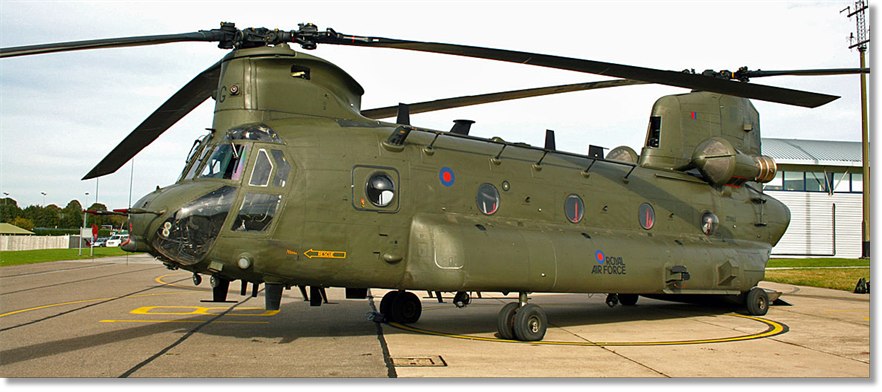
Britain's Royal Air Force (RAF) has placed an order worth over $580 million for Boeing to deliver 14 Chinook helicopters, exercising an option on an existing contract. The contracting agency for the Foreign Military Sales deal is U.S. Special Operations Command (USSOCOM).
To be delivered by July 2026, the new Chinooks will be to the latest Block II standard, making the UK the first overseas customer for the variant. Block II builds on the existing CH-47F aircraft with a series of improvements that enhance range, load-carrying ability, and electrical capacity for onboard equipment. The most notable difference is the fitment of the Advanced Chinook Rotor Blade (ACRB), which features a symmetric airfoil and advanced tip geometry to increase lifting ability. The Honeywell T55-715 engines provide around 20 percent more power.
Internal changes in the fuel sponsons either side of the fuselage increase capacity by reducing the number of cells from three to one, while the nose is more pointed to provide additional volume for sensor and other systems. A new drive system is installed, and an active parallel actuator system is fitted to enhance the Digital Advanced Flight Control System (DAFCS) by ensuring a precise division of torque between the two rotors.
“These Chinooks are the future of heavylift, built on an existing foundation of advanced capability and life cycle affordability,” said Andy Builta, Boeing vice president and H-47 program manager. “This contract for Block II aircraft sets the stage for the next 60 years of Chinook excellence on the battlefield.”
Boeing delivered the first Block II, an MH-47G optimized for special forces support, to USSOCOM in September 2020. Later this year, on September 21, the company will celebrate the CH-47’s first flight. The RAF was the first export customer for the CH-47, and has recently marked the 40th anniversary of the delivery of its first Chinook. The fleet has been heavily utilized and seen considerable action from its combat debut in the Falklands in 1982, through the 1991 Gulf War, to intense operations in Afghanistan. In 2018 a detachment also began operating in Mali. Some of the first aircraft to be received are still in service, albeit having undergone a series of upgrades and improvements, and in the UK’s latest defense and security review published in March the Ministry of Defence announced that nine of them would be retired.
The latest RAF order for the CH-47F Block II is likely to be delivered for special operations in a configuration close to that of USSOCOM’s MH-47G. In the meantime, the remainder of the fleet is being brought up to a common Chinook HC.Mk 6A standard, with the DAFCS replacing the original analog flight control system. The Mk 6A conversion program is due to be completed this year.
Defense News: Aviation International News
To be delivered by July 2026, the new Chinooks will be to the latest Block II standard, making the UK the first overseas customer for the variant. Block II builds on the existing CH-47F aircraft with a series of improvements that enhance range, load-carrying ability, and electrical capacity for onboard equipment. The most notable difference is the fitment of the Advanced Chinook Rotor Blade (ACRB), which features a symmetric airfoil and advanced tip geometry to increase lifting ability. The Honeywell T55-715 engines provide around 20 percent more power.
Internal changes in the fuel sponsons either side of the fuselage increase capacity by reducing the number of cells from three to one, while the nose is more pointed to provide additional volume for sensor and other systems. A new drive system is installed, and an active parallel actuator system is fitted to enhance the Digital Advanced Flight Control System (DAFCS) by ensuring a precise division of torque between the two rotors.
“These Chinooks are the future of heavylift, built on an existing foundation of advanced capability and life cycle affordability,” said Andy Builta, Boeing vice president and H-47 program manager. “This contract for Block II aircraft sets the stage for the next 60 years of Chinook excellence on the battlefield.”
Boeing delivered the first Block II, an MH-47G optimized for special forces support, to USSOCOM in September 2020. Later this year, on September 21, the company will celebrate the CH-47’s first flight. The RAF was the first export customer for the CH-47, and has recently marked the 40th anniversary of the delivery of its first Chinook. The fleet has been heavily utilized and seen considerable action from its combat debut in the Falklands in 1982, through the 1991 Gulf War, to intense operations in Afghanistan. In 2018 a detachment also began operating in Mali. Some of the first aircraft to be received are still in service, albeit having undergone a series of upgrades and improvements, and in the UK’s latest defense and security review published in March the Ministry of Defence announced that nine of them would be retired.
The latest RAF order for the CH-47F Block II is likely to be delivered for special operations in a configuration close to that of USSOCOM’s MH-47G. In the meantime, the remainder of the fleet is being brought up to a common Chinook HC.Mk 6A standard, with the DAFCS replacing the original analog flight control system. The Mk 6A conversion program is due to be completed this year.
Defense News: Aviation International News


From: Barry Tappenden, Shortstown, Beds
Subject: Hazmat meets Murphy
Good morning Tony,
A MAMS team was tasked to pick up some Claymore mines from Clark Air Base, Philippines. No problem, except some of the mines had to be loaded into the boom of the Beverley to ensure a correct trim. Take off was perfect, but for the USAF Air Controller telling us repeatedly “Your undercarriage hasn’t retracted!”
I was taking it easy with one of those “coffees” when the boom started to get very warm! After a few minutes smoke started billowing out into the boom. Cries of “$%*^%” rang out with the AQM (Air Quartermaster) getting quite pale as he explained in several expletives that the boom was on fire.
Subject: Hazmat meets Murphy
Good morning Tony,
A MAMS team was tasked to pick up some Claymore mines from Clark Air Base, Philippines. No problem, except some of the mines had to be loaded into the boom of the Beverley to ensure a correct trim. Take off was perfect, but for the USAF Air Controller telling us repeatedly “Your undercarriage hasn’t retracted!”
I was taking it easy with one of those “coffees” when the boom started to get very warm! After a few minutes smoke started billowing out into the boom. Cries of “$%*^%” rang out with the AQM (Air Quartermaster) getting quite pale as he explained in several expletives that the boom was on fire.
I had been told, believe it or not, that Claymore mines don’t like the heat. We were all looking at each wondering what we should do? Open the boom back doors and throw the mines out? That would take some time removing all the lashing tape that was securing the load! Only one thing to... sit on the load and wait. It was discovered that the smoke was coming from the heating system.
Eventually, after what seemed like a lifetime, the Captain had managed to control the heating by switching it off, while a worried AQM was poised at the ready with a very small fire extinguisher. The rest of the flight home was a little chilly.
Best regards, keep safe and let the fresh air in!
Barry
Eventually, after what seemed like a lifetime, the Captain had managed to control the heating by switching it off, while a worried AQM was poised at the ready with a very small fire extinguisher. The rest of the flight home was a little chilly.
Best regards, keep safe and let the fresh air in!
Barry
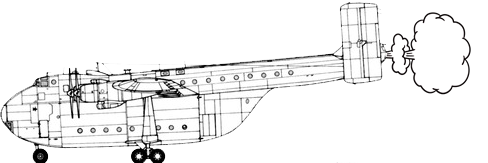

From: Budgie Baigent, Takaka, Tasman
Subject: Hazmat meets Murphy
Hi Tony,
Antarctica, November 1982 - I was the RNZAF liaison officer and load planner at McMurdo Station in Antarctica. Kiwi C130’s were landing on the sea ice runway bringing in personnel & supplies for the summer season and returning to Christchurch with small amounts of retrograde freight from Winter operations.
Subject: Hazmat meets Murphy
Hi Tony,
Antarctica, November 1982 - I was the RNZAF liaison officer and load planner at McMurdo Station in Antarctica. Kiwi C130’s were landing on the sea ice runway bringing in personnel & supplies for the summer season and returning to Christchurch with small amounts of retrograde freight from Winter operations.
A US Army Logistics Officer suggested our aircraft was being under utilized and wanted to fill it up with empty acetylene cylinders for return to Christchurch – these were usually retrograded by sea. I told him such items were ‘forbidden’ for shipment by air and refused to accept them – especially as none had been tested for leakage and many did not have blanking caps. He pulled rank and had several 463L pallets built then signed a ‘waiver’ overriding IATA and Military regs.
On arrival of our C130, I briefed the Kiwi ALM of the US Army Captain’s intent and my refusal to accept the load. Astonishingly, with a typical Kiwi ‘can do’ attitude, the ALM said he would take them as the aircraft was CAO and returning with just crew on board. I warned him of the serious consequences should any of the bottles leak but despite my sage advice the ALM confirmed his intent to carry them. I immediately told him I was relinquishing my post on the ice runway, would have no further participation with this turnaround and returned to McMurdo Station whereby I sent the Army Captain out to the aircraft with his manifests and ‘waivers’.
The aircraft duly departed with five pallets of bottles. Fifteen minutes later all hell broke loose as emergency teams and fire engines raced to the Ice runway – it turned out that on climbing to altitude the acetylene began to leak with fumes emanating throughout the aircraft. An emergency had been declared by the C130 Captain and the aircraft returned for a flaps up landing [due to reluctance to use any systems that may cause a spark], a long roll out, emergency shutdown and crew evacuation.
Shortly afterwards, I was summoned to the airfield to take control of the situation – my first action was to hand pump the ramp and door open and allow the fumes to dissipate. Next I had the cargo team break down the pallets, place the cylinders on the snow/ice at the end of the runway and return the empty pallets and TDE to McMurdo Station. By this time the aircrew had exceeded their crew hours so the aircraft was parked, after-flighted and the crew billeted for the night at McMurdo Station. Red faces all round and one US Army Captain had completed his last deployment to Antarctica!
An interesting post script to this story happened a couple of days later when the Captain sheepishly asked me what happened to the cylinders that were taken off the aircraft. I told him they were still sitting at the end of the runway and he could retrieve them any time he wanted and put them on the next SHIP bound for Christchurch. Of course the constant blowing snow envelopes anything lying exposed and to this day I don’t know if they were ever found and/or retrieved.
Cheers, Budgie
On arrival of our C130, I briefed the Kiwi ALM of the US Army Captain’s intent and my refusal to accept the load. Astonishingly, with a typical Kiwi ‘can do’ attitude, the ALM said he would take them as the aircraft was CAO and returning with just crew on board. I warned him of the serious consequences should any of the bottles leak but despite my sage advice the ALM confirmed his intent to carry them. I immediately told him I was relinquishing my post on the ice runway, would have no further participation with this turnaround and returned to McMurdo Station whereby I sent the Army Captain out to the aircraft with his manifests and ‘waivers’.
The aircraft duly departed with five pallets of bottles. Fifteen minutes later all hell broke loose as emergency teams and fire engines raced to the Ice runway – it turned out that on climbing to altitude the acetylene began to leak with fumes emanating throughout the aircraft. An emergency had been declared by the C130 Captain and the aircraft returned for a flaps up landing [due to reluctance to use any systems that may cause a spark], a long roll out, emergency shutdown and crew evacuation.
Shortly afterwards, I was summoned to the airfield to take control of the situation – my first action was to hand pump the ramp and door open and allow the fumes to dissipate. Next I had the cargo team break down the pallets, place the cylinders on the snow/ice at the end of the runway and return the empty pallets and TDE to McMurdo Station. By this time the aircrew had exceeded their crew hours so the aircraft was parked, after-flighted and the crew billeted for the night at McMurdo Station. Red faces all round and one US Army Captain had completed his last deployment to Antarctica!
An interesting post script to this story happened a couple of days later when the Captain sheepishly asked me what happened to the cylinders that were taken off the aircraft. I told him they were still sitting at the end of the runway and he could retrieve them any time he wanted and put them on the next SHIP bound for Christchurch. Of course the constant blowing snow envelopes anything lying exposed and to this day I don’t know if they were ever found and/or retrieved.
Cheers, Budgie
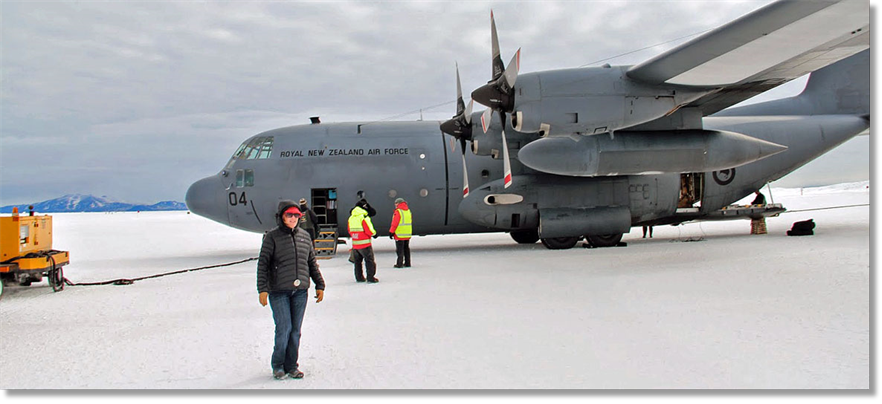

Ukrainians Breach the Perimeter Fence at Brize Norton!
The Antonov AN-225, the world's longest and heaviest operational aircraft, made a little visit to RAF Brize Norton on June 24th. After dropping off a few RAF Pumas, it departed and sort of broke the fence... I don't think the RAF are very happy!
From: Len Bowen, Chisholm, ACT
Subject: Hazmat meets Murphy - two tales to tell!
(This ‘tale’ has already appeared in the RAAF Supply Journal, and later in the RAF ‘Air Clues’ Flight Safety magazine as part of a larger article “I Leant about Air Movements from That”, under the sub-title “Don’t Assume! Check!”. N.B. I later received a £20 cheque from ‘Air Clues’ for the article – and a formal notification that the sum was taxable… but what the Aussie tax man doesn’t know about payments from UK won’t hurt the Australian balance of payments.)
Early 1968, and the Seletar-based 34 Sqn Beverleys were only a glorious footnote in the history books, replaced for strategic airlift out of Singapore by 48 Sqn Hercules based at RAF Changi. Equally early in 1968 my FEAF MAMS Team was tasked with loading 74 Squadron Lightning ground crew and support equipment out of RAF Tengah for a Sqn ‘show the flag’ deployment to RAF Kai Tak, Hong Kong. My Team was supposed to accompany the aircraft and assist with the off-load at Kai Tak, and thence a couple of days ‘on the town’ in Honkers. Alas, I did not accompany them, the reason for which will shortly become all too clear.
Subject: Hazmat meets Murphy - two tales to tell!
(This ‘tale’ has already appeared in the RAAF Supply Journal, and later in the RAF ‘Air Clues’ Flight Safety magazine as part of a larger article “I Leant about Air Movements from That”, under the sub-title “Don’t Assume! Check!”. N.B. I later received a £20 cheque from ‘Air Clues’ for the article – and a formal notification that the sum was taxable… but what the Aussie tax man doesn’t know about payments from UK won’t hurt the Australian balance of payments.)
Early 1968, and the Seletar-based 34 Sqn Beverleys were only a glorious footnote in the history books, replaced for strategic airlift out of Singapore by 48 Sqn Hercules based at RAF Changi. Equally early in 1968 my FEAF MAMS Team was tasked with loading 74 Squadron Lightning ground crew and support equipment out of RAF Tengah for a Sqn ‘show the flag’ deployment to RAF Kai Tak, Hong Kong. My Team was supposed to accompany the aircraft and assist with the off-load at Kai Tak, and thence a couple of days ‘on the town’ in Honkers. Alas, I did not accompany them, the reason for which will shortly become all too clear.
74 Squadron Lightnings at their home base, RAF Coltishall
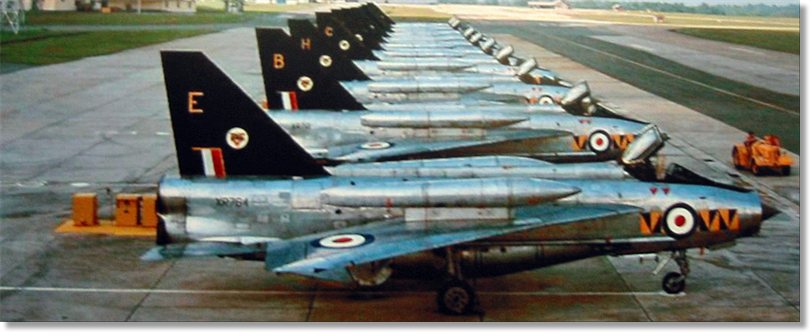
Inevitably, as with all Sqn deployments, the fly-away kit was late arriving at the Herc, as it was “essential” for the departing Lightnings. Last to arrive was the Sqn’s SWB Land Rover. My Flight Sergeant Ted and I gave it the once-over prior to loading. Blimey! It looked like a ‘before’ submission for an Air Movements School Dangerous Air Cargo (DAC) exam! Loose part-open cans of various aviation oils and fluids had just been flung loose into the back, there were even some starter cartridges in there, though I didn’t think at the time that Lightning used them, and the vehicle itself was completely un-prepped, with only a half tank of fuel and no battery caps.
Battery caps? Now here we delve into DAC history. Long ago in a galaxy far far away lead acid batteries had to be prepared for air transport with a little open-ended prophylactic fitted over each filling cap. This was apparently to prevent any acid spills or fume leaks. Honest!
Anyway, with the clock ticking towards chocks time on the Herc I advised the 74SQN Detachment SNCO in a calm scream to take the abomination away and prep it in accordance with the DAC leaflets that were part of every Sqn’s fly-away kit. The vehicle and SNCO driver, accompanied by a couple of 74 Sqn ‘erks’ disappeared into the gathering gloom of a Singapore late afternoon.
After what seemed like an age, but was probably only 15 minutes or so the vehicle re-appeared. Again in a calm roar I asked the SNCO if he had prepped the vehicle properly this time? “Yes. Sir. Exactly to the DAC Sheets”. OK; a quick walk round. Nothing now in the SWB load bed, and a glance at the fuel gauge now showing ¾ full as required. “Did you fit the little condoms to the battery, Flight?” “Yes Sir. (grumpily) Just like I said; by the DAC Sheets!” “Right”, I replied, let’s get the show on the road”.
With the Herc AQM looking at his watch and counting out the crew duty time, and ASSUMMING that the prep HAD been done properly, I don’t bother to check under the bonnet… More fool me!… “OK Flight, reverse the damned thing in up the ramp” which he duly did, but OMG there was liquid dripping out of the underside of the vehicle onto the almost pristine Herc floor. Quick finger taste test. Bloody hell; battery acid. Bloody Hell! Get the vehicle off again and away from the aircraft. Call Fire Section to wash down the ramp and neutralize the spill ASAP if not quicker.
Realization dawned. We belatedly opened the LR bonnet and sure enough each little condom was on its respective battery cap – upside down, hanging into the battery acid. A subsequent test by AMTDU proved that in some circumstances, especially when the battery acid level was very high and the battery was tilted – such as going up a C130 ramp - the prophylactics acted not as a barrier to spills but actually as syphons to drain acid out of the battery and onto the ramp!
More realization. By my assumption, we’d just had the first battery acid spill on the first FEAF C130 to have any damage whatsoever. OMG!
Battery caps? Now here we delve into DAC history. Long ago in a galaxy far far away lead acid batteries had to be prepared for air transport with a little open-ended prophylactic fitted over each filling cap. This was apparently to prevent any acid spills or fume leaks. Honest!
Anyway, with the clock ticking towards chocks time on the Herc I advised the 74SQN Detachment SNCO in a calm scream to take the abomination away and prep it in accordance with the DAC leaflets that were part of every Sqn’s fly-away kit. The vehicle and SNCO driver, accompanied by a couple of 74 Sqn ‘erks’ disappeared into the gathering gloom of a Singapore late afternoon.
After what seemed like an age, but was probably only 15 minutes or so the vehicle re-appeared. Again in a calm roar I asked the SNCO if he had prepped the vehicle properly this time? “Yes. Sir. Exactly to the DAC Sheets”. OK; a quick walk round. Nothing now in the SWB load bed, and a glance at the fuel gauge now showing ¾ full as required. “Did you fit the little condoms to the battery, Flight?” “Yes Sir. (grumpily) Just like I said; by the DAC Sheets!” “Right”, I replied, let’s get the show on the road”.
With the Herc AQM looking at his watch and counting out the crew duty time, and ASSUMMING that the prep HAD been done properly, I don’t bother to check under the bonnet… More fool me!… “OK Flight, reverse the damned thing in up the ramp” which he duly did, but OMG there was liquid dripping out of the underside of the vehicle onto the almost pristine Herc floor. Quick finger taste test. Bloody hell; battery acid. Bloody Hell! Get the vehicle off again and away from the aircraft. Call Fire Section to wash down the ramp and neutralize the spill ASAP if not quicker.
Realization dawned. We belatedly opened the LR bonnet and sure enough each little condom was on its respective battery cap – upside down, hanging into the battery acid. A subsequent test by AMTDU proved that in some circumstances, especially when the battery acid level was very high and the battery was tilted – such as going up a C130 ramp - the prophylactics acted not as a barrier to spills but actually as syphons to drain acid out of the battery and onto the ramp!
More realization. By my assumption, we’d just had the first battery acid spill on the first FEAF C130 to have any damage whatsoever. OMG!
Task Stonechat ~ or ~ 9,568 lb of Dangerous Air Cargo from UK to Woomera, Central Australia, in Several Not-Very-Easy Lessons
Fortunately, thanks to quick work by the Tengah Fire Section there was no real damage to the aircraft, and the task, with my MAMS Team aboard, was able to proceed to Kai Tak with minimal delay. Proceed without me, however, as I stayed behind to answer a few searching questions from my MAMS CO first thing the following morning and later have afternoon tea with the Station Commander with my hat on but without benefit of a cup and saucer. He didn’t assume anything when reviewing my shortcomings as a Movements Officer!
From Google: ‘The Falstaff rocket was used for British MoD experiments in second half of the 1970s. It used the largest solid booster ever built in the United Kingdom, the Royal Ordnance Stonechat. This motor (Stonechat Mk2) was 5.3 m long and 92 cm in diameter and weighed 5090 kg with 4340 kg of propellant. It delivered an average thrust of 240 kN during 37 seconds. Falstaff was launched seven times from Woomera’.
Sounds easy if you say it quickly, but getting a Stonechat from UK to Woomera, Central Australia, was not quite so simple ….what long haul air movements & transport task ever is?
I’d been posted to the Joint Air Transport Establishment (JATE) at RAF Abingdon in January 1973, having been ‘short-toured’ as Passenger Officer (PAXO) at RAF Luqa, Malta, when the Station went from ‘24/7’ operations to ‘Normal Working Hours, Five Days a Week’, and a substantial number of positions had been disestablished. I became one of the Project Officers on the JATE Fixed Wing Trials Squadron.
In mid-1974 JATE was given the task of moving the first Stonechat motor from RAF Abingdon to Woomera Rocket Range, Central Australia. The rocket motor was encased in a special travelling container 36 ft long and almost 8 ft square. The container was slid into an RAF C130 from a CONDEC 25K, bolted solidly onto the C130 roller conveyor system, and once in the Herc could only be off–loaded at its destination onto a similar flat-bed truck or trailer. With the container in position, movement from the front to the rear of the C130 fuselage (and so to the chemical toilet on the ramp) was virtually impassable, and in-flight jettisoning was impossible.
Hence the JATE MOVO (me) & and one of our ENGOs, had to pre-position in Singapore to meet up with the load for the short(er?) flights from RSAF Base Tengah to RAAF Base Darwin, then onto Woomera the following day – at least that was the plan. Oh, and any in-flight emergency involving the solid fuel rocket propellant would have resulted in us being the first C130K in orbit – albeit very briefly!
Sounds easy if you say it quickly, but getting a Stonechat from UK to Woomera, Central Australia, was not quite so simple ….what long haul air movements & transport task ever is?
I’d been posted to the Joint Air Transport Establishment (JATE) at RAF Abingdon in January 1973, having been ‘short-toured’ as Passenger Officer (PAXO) at RAF Luqa, Malta, when the Station went from ‘24/7’ operations to ‘Normal Working Hours, Five Days a Week’, and a substantial number of positions had been disestablished. I became one of the Project Officers on the JATE Fixed Wing Trials Squadron.
In mid-1974 JATE was given the task of moving the first Stonechat motor from RAF Abingdon to Woomera Rocket Range, Central Australia. The rocket motor was encased in a special travelling container 36 ft long and almost 8 ft square. The container was slid into an RAF C130 from a CONDEC 25K, bolted solidly onto the C130 roller conveyor system, and once in the Herc could only be off–loaded at its destination onto a similar flat-bed truck or trailer. With the container in position, movement from the front to the rear of the C130 fuselage (and so to the chemical toilet on the ramp) was virtually impassable, and in-flight jettisoning was impossible.
Hence the JATE MOVO (me) & and one of our ENGOs, had to pre-position in Singapore to meet up with the load for the short(er?) flights from RSAF Base Tengah to RAAF Base Darwin, then onto Woomera the following day – at least that was the plan. Oh, and any in-flight emergency involving the solid fuel rocket propellant would have resulted in us being the first C130K in orbit – albeit very briefly!
On or about 16/17 Sep 74, Stonechat loaded onto C130K XV217 at RAF Abingdon, captain Flt Lt Roger Payne, and departed for Singapore, via Akrotiri and Gan.
18 Sep 74. JATE Team departed RAF Lyneham on RAF VC10 XV108, again via Akrotiri and Gan, arriving in Singapore on 19 Sept 74 – to find that the Herc has arrived at Tengah on three engines and required an engine change.
19 – 24 Sep 74. Remained in Singapore, staying at the Hotel Equatorial on Bukit Timah Road. Excellent accommodation, and every intention of exploring my old haunts from my FEAF MAMS days. Unfortunately, the Golden Phoenix Restaurant in the hotel was a traditional Chinese restaurant serving Szchuan cooking. Despite my three years in the Far East 1965 – 68 I’d never encountered genuine Szchuan food.
18 Sep 74. JATE Team departed RAF Lyneham on RAF VC10 XV108, again via Akrotiri and Gan, arriving in Singapore on 19 Sept 74 – to find that the Herc has arrived at Tengah on three engines and required an engine change.
19 – 24 Sep 74. Remained in Singapore, staying at the Hotel Equatorial on Bukit Timah Road. Excellent accommodation, and every intention of exploring my old haunts from my FEAF MAMS days. Unfortunately, the Golden Phoenix Restaurant in the hotel was a traditional Chinese restaurant serving Szchuan cooking. Despite my three years in the Far East 1965 – 68 I’d never encountered genuine Szchuan food.
24 Sep 74. Evening. After parking XV217 in the furthest corner of Darwin airfield, the RAF crew & JATE team repaired to the Darwin Travel Lodge Hotel. This was the only ‘new’ hotel in town (and the only one later to survive Cyclone Tracy that all but destroyed on Christmas Day December 1974). After several excellent cold Northern Territory Bitter (NT Bitter) beers in the bar, we met up and started drinking with a group of Australian cattle drovers. They had just brought a big mob of beasts into town for shipment overseas, and were intent on ‘cutting out their pay cheques’ as quickly as possible. Later we adjourned to dinner on the hotel restaurant to eat the biggest steaks we Brits had seen – or could afford - for years (thank you flight imprest). Our RAF team decided to order wine, but the Aussie mob stayed on beer.
One recipe from ‘The Flavour of Singapore’, Page 41, starts “4 oz dry red chilies (this amounts to nearly a handful if you try this at home). Fry till black and remove from oil” … then proceeds with the rest of the dish, cooked in the chilli oil and with the blackened chilies returned to the meal just before serving. I will gloss over the next 36 hours in the hotel, but suffice it to say that my mean operating radius from my room’s en-suite was about 10 feet, whimpering and sweating during each visit! Did actually see some of Singapore, though somewhat later than planned.
24 Sep 74. 11:20 local. Departed Tengah C130 XV217, Captain: Flt Lt Roger Payne (actually an Australian but serving with the RAF – of which more later), for RAAF Base Darwin. About halfway through the flight, somewhere over the Timor Sea, the AQM on his scan-check noticed that the spinner on No 2, the engine changed at Tengah, was flailing loose. Obviously it had not been properly locked down during the change. No 2 was shut down and a priority landing at Darwin requested. On landing the spinner finally became detached and nearly decapitated the RAAF fireman standing up behind the foam gun on the fire tender that was following us down the runway. The RAAF staff were not delighted to have an RAF Herc with a load of over 4,300 kg NEQ stranded on their base while we got a new spinner from somewhere.
24 Sep 74. 11:20 local. Departed Tengah C130 XV217, Captain: Flt Lt Roger Payne (actually an Australian but serving with the RAF – of which more later), for RAAF Base Darwin. About halfway through the flight, somewhere over the Timor Sea, the AQM on his scan-check noticed that the spinner on No 2, the engine changed at Tengah, was flailing loose. Obviously it had not been properly locked down during the change. No 2 was shut down and a priority landing at Darwin requested. On landing the spinner finally became detached and nearly decapitated the RAAF fireman standing up behind the foam gun on the fire tender that was following us down the runway. The RAAF staff were not delighted to have an RAF Herc with a load of over 4,300 kg NEQ stranded on their base while we got a new spinner from somewhere.
Now this was, if you will remember, 1974, before the Australian wine industry had reached its full potential, and certainly before its better products had reached the Top End. As a result the product we were drinking was certainly not Penfold Grange Hermitage. Our skipper Roger, as already noted himself an Australian but now with little Aussi accent thanks to his time with the RAF, undertook an English-style wine appreciation comment, in a very plumy Pommy Accent: “An interesting drop. Slightly thick legs. Definitely some barrel taint. An unusual aftertaste” then dropping back to a thick Australian accent, “Compares rather f******g unfavorably with Wallaby piss!”
The Aussie drovers, now very well oiled on NT Bitter, and though knowing full well that the ‘wine’ we Brits were drinking did indeed compare unfavorably with marsupial urine, decided nonetheless that no Pom should extract said urine from Australian wines. They were just about to give us a good seeing-to when Roger quickly switched back to his normal Aussie twang and assured the lads that he himself was True Blue Oz and therefore allowed to comment on the plonk with which we had been presented. Australian honour satisfied, peace was restored, and several more NT Bitters were consumed, to remove the aftertaste of the ‘wine’.
26 Sep 74. A new spinner having been sourced from the RAAF Herc fleet at RAAF Base Richmond, on to Woomera. Departed Darwin at 12:20 local, so after a 4 ¾ hour flight, arrived at Woomera late in the afternoon.
The Aussie drovers, now very well oiled on NT Bitter, and though knowing full well that the ‘wine’ we Brits were drinking did indeed compare unfavorably with marsupial urine, decided nonetheless that no Pom should extract said urine from Australian wines. They were just about to give us a good seeing-to when Roger quickly switched back to his normal Aussie twang and assured the lads that he himself was True Blue Oz and therefore allowed to comment on the plonk with which we had been presented. Australian honour satisfied, peace was restored, and several more NT Bitters were consumed, to remove the aftertaste of the ‘wine’.
26 Sep 74. A new spinner having been sourced from the RAAF Herc fleet at RAAF Base Richmond, on to Woomera. Departed Darwin at 12:20 local, so after a 4 ¾ hour flight, arrived at Woomera late in the afternoon.
Fortunately, the RAAF having had Hercs (C130As) in their inventory since the mid 1960s, Woomera was equipped with a long roller-fitted semitrailer. This was duly maneuvered into position for the offload – or rather not into position, as the civilian marshalling – or trying to marshal - the truck driver clearly had no idea of the hand signals necessary to achieve a safe link-up to our Herc’s sill. After several attempts, which were becoming more and more erratic and potentially more dangerous to our aircraft I stepped in. “OK, I’ll take over the marshalling”
“No you bloody well won’t” (didn’t actually add “You Pommy Bastard” but it was implicit in his tone). “This is my Base and I’ll do the marshalling”.
I very quickly added, “Yes, but that’s an RAF aircraft, with a British load aboard, and until it is on Australian soil it’s my responsibility. I’ll take over the marshalling now”… and did. After just one more try, and much to my and the truck driver’s relief the semi was in place and the Stonechat container rolled out of the Herc [see photos] and onto Australian soil – or rather onto an Australian trailer.
Honour was satisfied, though the original ‘marshaller’ stormed off in disgust, while the truck driver thanked me with the comment “Don’t worry about Fred; he’s a bit of a wanker at the best of times. Ta, mate, for the clear signals. I was getting worried that I’d hit your bird” Him and me both!
“No you bloody well won’t” (didn’t actually add “You Pommy Bastard” but it was implicit in his tone). “This is my Base and I’ll do the marshalling”.
I very quickly added, “Yes, but that’s an RAF aircraft, with a British load aboard, and until it is on Australian soil it’s my responsibility. I’ll take over the marshalling now”… and did. After just one more try, and much to my and the truck driver’s relief the semi was in place and the Stonechat container rolled out of the Herc [see photos] and onto Australian soil – or rather onto an Australian trailer.
Honour was satisfied, though the original ‘marshaller’ stormed off in disgust, while the truck driver thanked me with the comment “Don’t worry about Fred; he’s a bit of a wanker at the best of times. Ta, mate, for the clear signals. I was getting worried that I’d hit your bird” Him and me both!
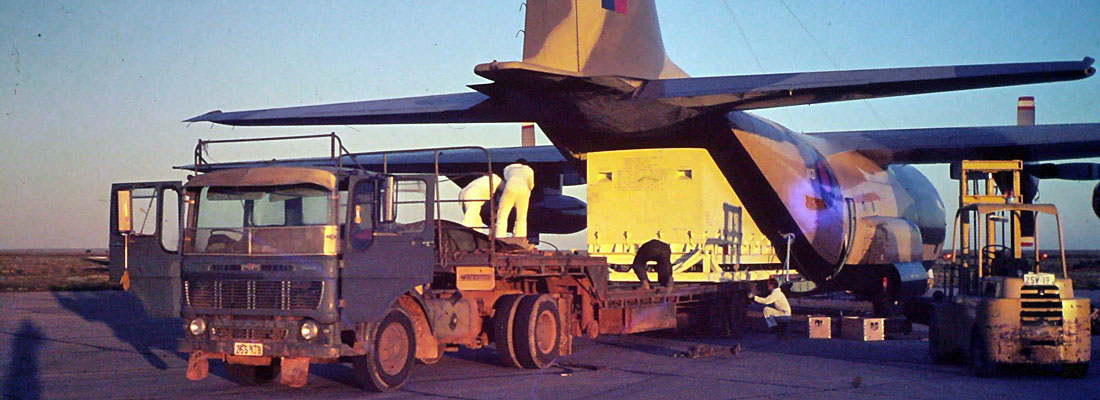
Offload completed, we all adjourned to the Woomera pub and hotel, the Eldo, named after a series of previous rocket trials. Several beers, another excellent steak, no more Oz wine tastings and so to bed for a good night’s sleep. Oh yeah?
27 Sep 74. 02:30. Knock on my room door. The AQM. “Sir. They need us out at the aircraft. We’ve got a back-load for UK, and it’s got to be loaded right now, tonight!” Groggily out of bed. Quick shower and into my flying suit, outside for transport out to the aircraft. OMG It’s cold! We’re in the middle of Australia and it’s bloody freezing! We were delivering a load to Australia, a warm country, so I only had a lightweight flying suit with me, through which the night wind was passing as if I was stark bloody naked! Idiot! Woomera is in the middle of a desert, and deserts get cold at night! Oh well, it’ll be OK once at the aircraft, out of the wind.
It wasn’t. The wind seemed to be coming straight through the fuselage sides, and while we waited for this mysterious load that ‘had to be on board tonight’ the AQM and I tried to find a warm spot and couldn’t. When the load finally arrived, nearer to 04:00 than the 03:00 we’d been promised, it turned out to be five very large and unmarked containers. They had been weighed, we were assured, and were ready to go. “What’s in them?”
“Earth”.
“Earth? To have to be loaded in the dead of night! Why?”.
“Don’t ask, just get them on board. Here’s the Tasking Order”.
27 Sep 74. 02:30. Knock on my room door. The AQM. “Sir. They need us out at the aircraft. We’ve got a back-load for UK, and it’s got to be loaded right now, tonight!” Groggily out of bed. Quick shower and into my flying suit, outside for transport out to the aircraft. OMG It’s cold! We’re in the middle of Australia and it’s bloody freezing! We were delivering a load to Australia, a warm country, so I only had a lightweight flying suit with me, through which the night wind was passing as if I was stark bloody naked! Idiot! Woomera is in the middle of a desert, and deserts get cold at night! Oh well, it’ll be OK once at the aircraft, out of the wind.
It wasn’t. The wind seemed to be coming straight through the fuselage sides, and while we waited for this mysterious load that ‘had to be on board tonight’ the AQM and I tried to find a warm spot and couldn’t. When the load finally arrived, nearer to 04:00 than the 03:00 we’d been promised, it turned out to be five very large and unmarked containers. They had been weighed, we were assured, and were ready to go. “What’s in them?”
“Earth”.
“Earth? To have to be loaded in the dead of night! Why?”.
“Don’t ask, just get them on board. Here’s the Tasking Order”.
Reality dawns. Just up the road from Woomera, relatively speaking, is Maralinga where in the 1950s the Brits had done some very nasty things with atomic bomb testing, and by the 1970s enough details had surfaced (unfortunate choice of words) for the Australians to demand that some sort of remediation of the sites take place.
These five containers obviously held contaminated soil to be shipped back to UK for disposal! Damn, and I forgot to pack my lead jock strap!
Anyway, the Task Order was clear and specific, so onboard went the five containers, and the AQM and I tied them down as quickly as possible and vacated the aircraft.
We left Woomera for Darwin at 09:35 later the same morning, with the downstairs PAX sitting as far away as possible from the five containers. Then after another but much shorter overnight at the Travel Lodge Hotel, we’re on our way to Tengah at 05:15 the following morning.
At Tengah the JATE team waved goodbye to the Herc crew and their dubious load, and after a further couple of nights back at the Equatorial Hotel, but avoiding any genuine Szechwan cooking this time, returned to the UK in the comfort of a VC10 on 1st October.
Footnote: I met Roger Payne a few months later when he brought a Herc up to Abingdon from Lynham for a local JATE task. He didn’t glow in the dark, but did admit that the entire crew of XV217 spent the whole time from Tengah to the UK on the flight deck, with the door closed and only very essential and equally very quick back downstairs to the dunny on the ramp!
J.L.B. Canberra 28 Jun 2021.
These five containers obviously held contaminated soil to be shipped back to UK for disposal! Damn, and I forgot to pack my lead jock strap!
Anyway, the Task Order was clear and specific, so onboard went the five containers, and the AQM and I tied them down as quickly as possible and vacated the aircraft.
We left Woomera for Darwin at 09:35 later the same morning, with the downstairs PAX sitting as far away as possible from the five containers. Then after another but much shorter overnight at the Travel Lodge Hotel, we’re on our way to Tengah at 05:15 the following morning.
At Tengah the JATE team waved goodbye to the Herc crew and their dubious load, and after a further couple of nights back at the Equatorial Hotel, but avoiding any genuine Szechwan cooking this time, returned to the UK in the comfort of a VC10 on 1st October.
Footnote: I met Roger Payne a few months later when he brought a Herc up to Abingdon from Lynham for a local JATE task. He didn’t glow in the dark, but did admit that the entire crew of XV217 spent the whole time from Tengah to the UK on the flight deck, with the door closed and only very essential and equally very quick back downstairs to the dunny on the ramp!
J.L.B. Canberra 28 Jun 2021.

CONTEST!
You could win 1 of 4 (pre-1982) Royal Canadian Air Force Ensigns
You could win 1 of 4 (pre-1982) Royal Canadian Air Force Ensigns
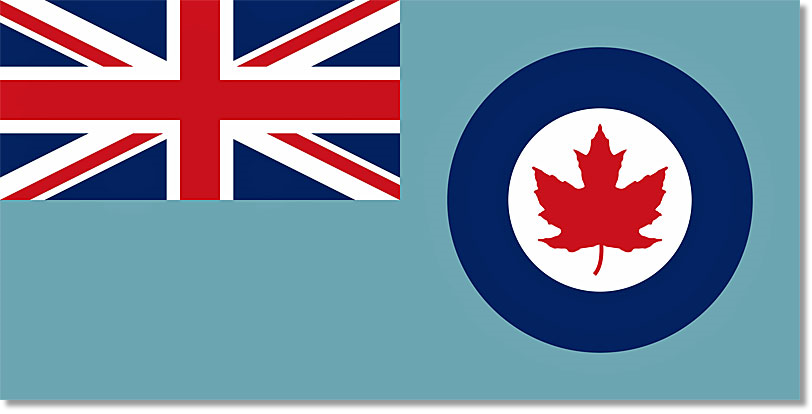
(In 1921, one year after the Canadian Air Force was founded, permission was granted for the Canadian Air Force to use the Royal Air Force Ensign. In February 1921, the Air Officer Commanding the Canadian Air Force, Air Commodore Arthur Tylee, turned his attention to the matter of what might make a suitable flag for the Air Force. In a note he wrote to the Inspector-General of the Canadian Air Force, Air Vice-Marshal Sir Willoughby Gwatkin, Tylee proposed that the RAF Ensign be adopted with a maple leaf at the centre of the roundel. Gwatkin in turn applied to Air Marshal Sir Hugh Trenchard, the British Chief of the Air Staff, who rejected the proposal on the basis that "the sentiment of unity between the Air Services of the Empire" ought to be maintained.
During World War II the question of a specifically Canadian air force flag was raised again and in July 1940 the Royal Canadian Air Force adopted its own ensign by replacing the red disc at the centre of the RAF Ensign with a red maple leaf. This design remained as the Royal Canadian Air Force Ensign until the Canadian Red Ensign was superseded by the new Canadian National Flag in 1965 and the RCAF ensign ceased to be used officially.
In 1982 the then Canadian Forces Air Command adopted the current flag. The ensign has a field of air force blue like the original RCAF Ensign but the Union Flag was replaced with the Canadian Maple Leaf Flag in the canton and the roundel featured a more stylized maple leaf than the original roundel.)
During World War II the question of a specifically Canadian air force flag was raised again and in July 1940 the Royal Canadian Air Force adopted its own ensign by replacing the red disc at the centre of the RAF Ensign with a red maple leaf. This design remained as the Royal Canadian Air Force Ensign until the Canadian Red Ensign was superseded by the new Canadian National Flag in 1965 and the RCAF ensign ceased to be used officially.
In 1982 the then Canadian Forces Air Command adopted the current flag. The ensign has a field of air force blue like the original RCAF Ensign but the Union Flag was replaced with the Canadian Maple Leaf Flag in the canton and the roundel featured a more stylized maple leaf than the original roundel.)
Contest Details
Four RCAF ensigns, 36" x 72", suitable for either indoor or seasonal outdoor use, have been generously donated by Earle Dawson of the Western Traffic Techs.
For your opportunity to win one of these beautiful ensigns, simply send me an e-mail with a compelling story or reason why you deserve to own one.
The closing date for the contest will be Thursday, 29th July inst., and the winners will be announced in the newsletter at the end of July.
Good Luck!
Four RCAF ensigns, 36" x 72", suitable for either indoor or seasonal outdoor use, have been generously donated by Earle Dawson of the Western Traffic Techs.
For your opportunity to win one of these beautiful ensigns, simply send me an e-mail with a compelling story or reason why you deserve to own one.
The closing date for the contest will be Thursday, 29th July inst., and the winners will be announced in the newsletter at the end of July.
Good Luck!

RAF Brize Norton Air Mobility Force
Watch our Air Mobility Force in action across the globe, delivering flexible, strategic capabilities at speed in support of UK Defence. Everything relies on Air Mobility!

Danish Loadmasters Think Creatively
When the key loader, the wagon that normally picks up the load, breaks down, a loadmaster must find alternative ways to get the load out of a Hercules. Two loadmaster students were exposed to just that scenario when last week they had to show what they had learned in their education. The method is also often used when delivering supplies to Station Nord [Greenland]. They do not have a key loader there.

RAF C-130J Hercules detachment in the Middle East
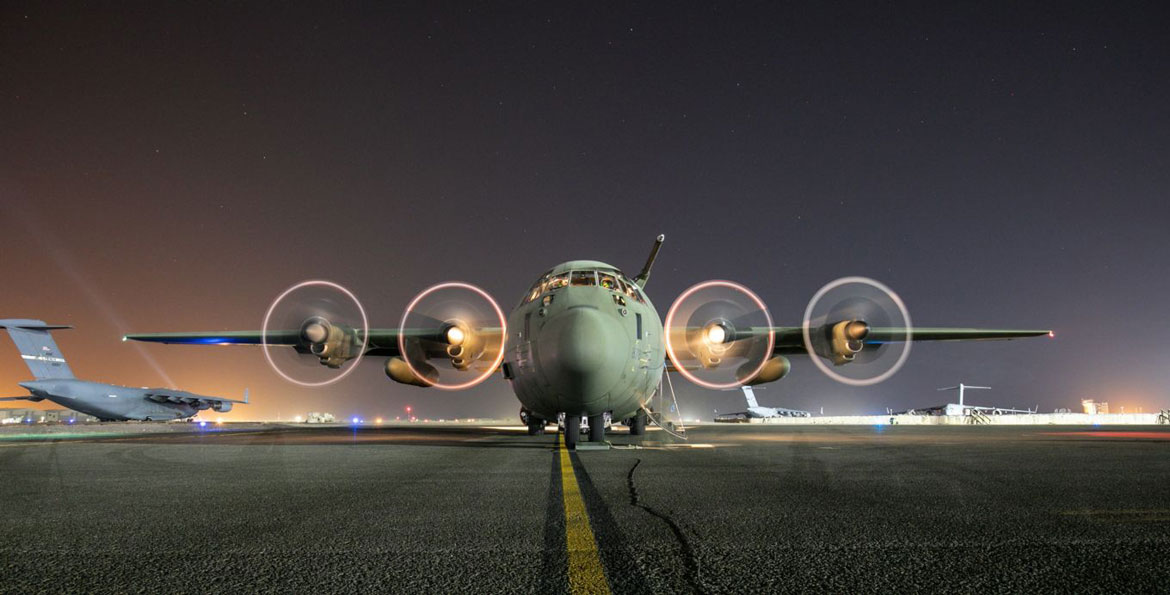
A Hercules C-130J detachment from RAF Brize Norton is based in the Middle East to carry out vital supply runs in support of the UK Operations across the Middle East. The RAF Hercules detachment, consisting of aircraft and personnel from both 47 and 24 Squadrons, together with individual augmentees, are deployed to provide a tactical air transport capability that provides air mobility in challenging and austere conditions.
Squadron Leader Fairley, C-130J Detachment Commander said, “The C-130J has provided the backbone to the RAF’s tactical airlift capability in the Middle East since the start of Operation Shader in 2014. We routinely operate under the cover of darkness to deliver critical support across both to Operation Shader and Operation Kipion enabling operations to continue in the ongoing fight against Daesh in Iraq and Syria.”
Each Hercules sortie typically involve not just the aircrew, but RAF Force Protection, Ground Engineers and Mover personnel to make the flights self supporting. This means that for each flight the ground engineers, will routinely on arrival conduct essential checks and carry out maintenance. The RAF Regiment Gunners will deploy to provide security for the aircraft, while the movers will load and unload passengers and cargo at any of the destination around the Middle East.
Sergeant Angell, C130J Engineer said, “As a Ground Engineer I accompany the aircraft wherever it may go around the world, providing engineering support and to address any issues that may arise when we are away from our main operating base. The ability for Ground Engineers to fly with the C-130 gives the flexibility to cover everything from flight servicing and refuels to fix and sign for almost any job required. This is essential to ensuring the aircraft delivers its operational tasking in support of counter Daesh operations in the Middle East.”
On average the detachment moves over 200 troops into theatre and up to 40 tonnes of freight in support of the mission each month. The freight ranges from critical aircraft and vehicle spares, COVID-19 Vaccines and real-life support kit for the deployed forces.
Royal Air Force
Squadron Leader Fairley, C-130J Detachment Commander said, “The C-130J has provided the backbone to the RAF’s tactical airlift capability in the Middle East since the start of Operation Shader in 2014. We routinely operate under the cover of darkness to deliver critical support across both to Operation Shader and Operation Kipion enabling operations to continue in the ongoing fight against Daesh in Iraq and Syria.”
Each Hercules sortie typically involve not just the aircrew, but RAF Force Protection, Ground Engineers and Mover personnel to make the flights self supporting. This means that for each flight the ground engineers, will routinely on arrival conduct essential checks and carry out maintenance. The RAF Regiment Gunners will deploy to provide security for the aircraft, while the movers will load and unload passengers and cargo at any of the destination around the Middle East.
Sergeant Angell, C130J Engineer said, “As a Ground Engineer I accompany the aircraft wherever it may go around the world, providing engineering support and to address any issues that may arise when we are away from our main operating base. The ability for Ground Engineers to fly with the C-130 gives the flexibility to cover everything from flight servicing and refuels to fix and sign for almost any job required. This is essential to ensuring the aircraft delivers its operational tasking in support of counter Daesh operations in the Middle East.”
On average the detachment moves over 200 troops into theatre and up to 40 tonnes of freight in support of the mission each month. The freight ranges from critical aircraft and vehicle spares, COVID-19 Vaccines and real-life support kit for the deployed forces.
Royal Air Force

RCAF's Op IMPACT has Emotional Impact for OBA Member
It was an emotional moment for [OBA Member] Chief Warrant Officer (CWO) April Roach when she met her son, Corporal Zachary Roach, earlier this month. It was a unique meeting as both mother and the son are currently deployed on Operation IMPACT.
“It was a great feeling,” says CWO Roach when she was able to see her son doing his job on a mission. “Seeing him in his own element, doing his own job on operation, I thought to myself he is no longer my little boy. He's a big man unloading a plane. It was a moving moment. Before the meeting I was trying to be cool, I said maybe he wants to do the elbow thing and say hello. But the minute I got to the bottom of the ramp and saw him, his arms were open wide for a hug."
Their paths only crossed for a short while, but it was enough to allow them a chance to talk and exchange news. “He’s Cpl and I’m the Chief, but he’s still my child,” said CWO Roach with emotion. The last time the two were together was over Christmas.
CWO Roach and Cpl Roach both serve as Traffic Technicians. She is deployed on Op IMPACT in Kuwait as Air Task Force Chief Warrant Officer - IMPACT since May 2021, while Cpl Zachary Roach who is part of 2 Service Battalion Petawawa is deployed as a Traffic Technician.
'Mama Roach' as her colleagues at the camp call her, has 30 years of service in the Canadian Armed Forces. 21-year-old Zachary enlisted at 17, the same age she was when she joined the CAF. Zachary has chosen to follow the same path as his mother. “It's very special to be with your children on deployment and wear the same medals on commemorative parades such as Remembrance Day.” Said CWO Roach.
Royal Canadian Air Force
“It was a great feeling,” says CWO Roach when she was able to see her son doing his job on a mission. “Seeing him in his own element, doing his own job on operation, I thought to myself he is no longer my little boy. He's a big man unloading a plane. It was a moving moment. Before the meeting I was trying to be cool, I said maybe he wants to do the elbow thing and say hello. But the minute I got to the bottom of the ramp and saw him, his arms were open wide for a hug."
Their paths only crossed for a short while, but it was enough to allow them a chance to talk and exchange news. “He’s Cpl and I’m the Chief, but he’s still my child,” said CWO Roach with emotion. The last time the two were together was over Christmas.
CWO Roach and Cpl Roach both serve as Traffic Technicians. She is deployed on Op IMPACT in Kuwait as Air Task Force Chief Warrant Officer - IMPACT since May 2021, while Cpl Zachary Roach who is part of 2 Service Battalion Petawawa is deployed as a Traffic Technician.
'Mama Roach' as her colleagues at the camp call her, has 30 years of service in the Canadian Armed Forces. 21-year-old Zachary enlisted at 17, the same age she was when she joined the CAF. Zachary has chosen to follow the same path as his mother. “It's very special to be with your children on deployment and wear the same medals on commemorative parades such as Remembrance Day.” Said CWO Roach.
Royal Canadian Air Force
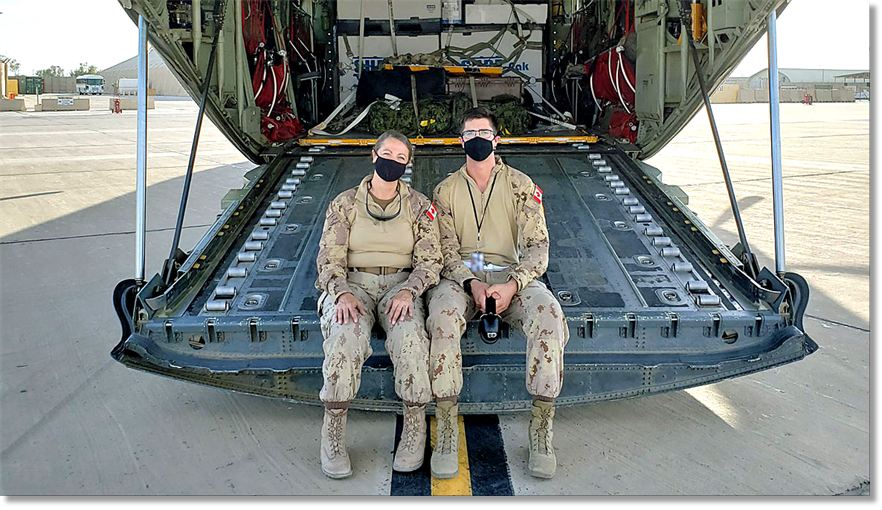

From: Axel Jinadu, Mallorca
Subject: The List - Airport Technical Support Roles (Afghanistan)
Hi Tony,
Trust this finds you well!
Can you spread the word on this in case anyone in your extensive network is interested or knows someone who is? I can connect any takers to James or they can reach out to him direct.
Keep well buddy
Regards as ever, Axel
--------------------------------
From: James Francis-Jones, Westbury, Wilts
To: Axel Jinadu MA FCMI
Subject: The List - Airport Technical Support Roles (Afghanistan)
Dear Axel,
Immediate aviation opportunities, for ex-services members, working at a civilian International Airport in Afghanistan (12 month contract, renewable).
Subject: The List - Airport Technical Support Roles (Afghanistan)
Hi Tony,
Trust this finds you well!
Can you spread the word on this in case anyone in your extensive network is interested or knows someone who is? I can connect any takers to James or they can reach out to him direct.
Keep well buddy
Regards as ever, Axel
--------------------------------
From: James Francis-Jones, Westbury, Wilts
To: Axel Jinadu MA FCMI
Subject: The List - Airport Technical Support Roles (Afghanistan)
Dear Axel,
Immediate aviation opportunities, for ex-services members, working at a civilian International Airport in Afghanistan (12 month contract, renewable).
Opportunity Title |
Monthly Salary |
Bonus |
Click for |
CNS Assistant Manager |
$10,000 |
$6,000 |
|
CNS Technician for the Communication & IT Section |
$8,000 |
$4,800 |
|
CNS Technician for Instrument Landing System (ILS) |
$8,000 |
$4,800 |
|
CNS Technician for Aeronautical Ground Lighting (AGL) |
$8,000 |
$4,800 |
|
CNS Technician for Surveillance Radars |
$8,000 |
$4,800 |
|
CNS Technician for Electrical Supply & HVAC (CNS equip) |
$7,000 |
$4,800 |
|
ARFF Assistant Manager |
$9,000 |
$5,400 |
|
ARFF Trainer |
$7,000 |
$4,200 |
|
MET Assistant Manager & Trainer |
$9,000 |
$5,400 |
|
MET Observer & Forecaster |
$7,000 |
$4,200 |
|
SMS Assistant Manager |
$9,000 |
$5,400 |
|
SMS Trainer |
$8,000 |
$4,800 |
|
Project Manager (Aviation) |
$12,000 |
$7,200 |
NB. All opportunities come with accommodation.
If interested, please reply with:
• CV
• ‘Opportunity Title’ in the subject line
• No cover letter
Client disclosure & full JD will follow to those thought to be suitable, following an initial assessment.
Other opportunities are available on line: Web Site; LinkedIn and Facebook.
James Francis-Jones
If interested, please reply with:
• CV
• ‘Opportunity Title’ in the subject line
• No cover letter
Client disclosure & full JD will follow to those thought to be suitable, following an initial assessment.
Other opportunities are available on line: Web Site; LinkedIn and Facebook.
James Francis-Jones

TANNERS & BOBS
Back in the days of tanners and bobs,
When Mothers had patience and Fathers had jobs.
When football team families wore hand me down shoes,
And TV gave only two channels to choose.
Back in the days of threepenny bits,
when schools employed nurses to search for your nits.
When snowballs were harmless; ice slides were permitted
and all of your jumpers were warm and hand knitted.
Back in the days of hot ginger beers,
when children remained so for more than six years.
When children respected what older folks said,
and pot was a thing you kept under your bed.
Back in the days of Listen with Mother,
when neighbours were friendly and talked to each other.
When cars were so rare you could play in the street.
When Doctors made house calls and Police walked the beat.
Back in the days of Milligan's Goons,
when butter was butter and songs all had tunes.
It was dumplings for dinner and trifle for tea,
and your annual break was a day by the sea.
Back in the days of Dixon's Dock Green,
Crackerjack pens and Lyon’s ice cream.
When children could freely wear National Health glasses,
and teachers all stood at the FRONT of their classes.
Back in the days of rocking and reeling,
when mobiles were things that you hung from the ceiling.
When woodwork and pottery got taught in schools,
and everyone dreamed of a win on the pools.
Back in the days when I was a lad,
I can't help but smile for the fun that I had.
Hopscotch and roller skates; snowballs to lob.
Back in the days of tanners and bobs.
When Mothers had patience and Fathers had jobs.
When football team families wore hand me down shoes,
And TV gave only two channels to choose.
Back in the days of threepenny bits,
when schools employed nurses to search for your nits.
When snowballs were harmless; ice slides were permitted
and all of your jumpers were warm and hand knitted.
Back in the days of hot ginger beers,
when children remained so for more than six years.
When children respected what older folks said,
and pot was a thing you kept under your bed.
Back in the days of Listen with Mother,
when neighbours were friendly and talked to each other.
When cars were so rare you could play in the street.
When Doctors made house calls and Police walked the beat.
Back in the days of Milligan's Goons,
when butter was butter and songs all had tunes.
It was dumplings for dinner and trifle for tea,
and your annual break was a day by the sea.
Back in the days of Dixon's Dock Green,
Crackerjack pens and Lyon’s ice cream.
When children could freely wear National Health glasses,
and teachers all stood at the FRONT of their classes.
Back in the days of rocking and reeling,
when mobiles were things that you hung from the ceiling.
When woodwork and pottery got taught in schools,
and everyone dreamed of a win on the pools.
Back in the days when I was a lad,
I can't help but smile for the fun that I had.
Hopscotch and roller skates; snowballs to lob.
Back in the days of tanners and bobs.
This newsletter is dedicated
to the memories of:
Robert Walker (RCAF)
Michael (Chick) Hatch (RAF)
to the memories of:
Robert Walker (RCAF)
Michael (Chick) Hatch (RAF)
Tony Gale
ukmamsoba@gmail.com
(If you wish to help out with the costs, you may use the above
e-mail to make a donation via
PayPal)
ukmamsoba@gmail.com
(If you wish to help out with the costs, you may use the above
e-mail to make a donation via
PayPal)
.
